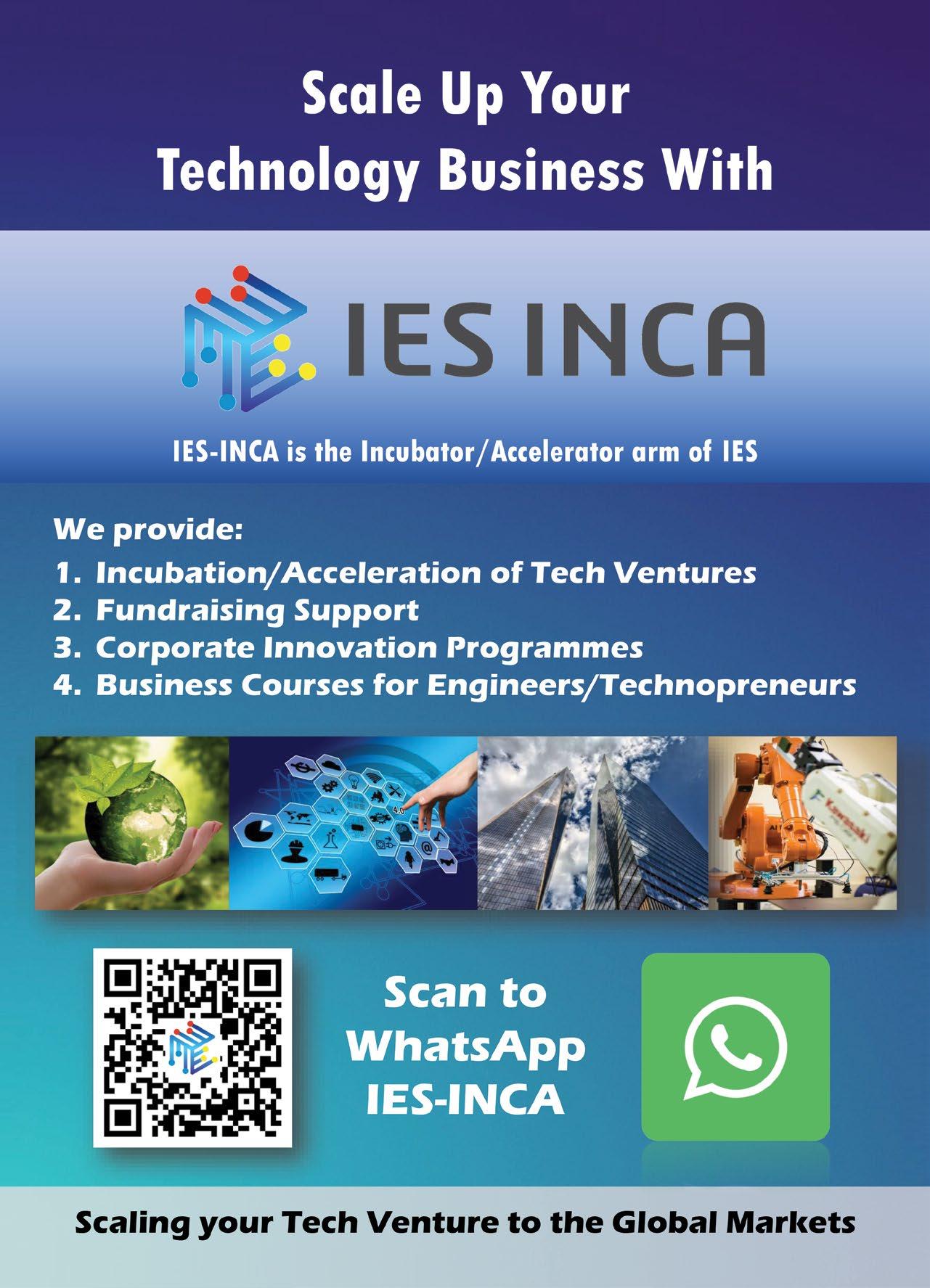
www.ies.org.sg


www.ies.org.sg
WORKPLACE SAFETY & HEALTH: Workplace fatal and major injury rates for 2023 at record low
COLLABORATIVE CONTRACTING: L aunch of NEC4 contract for construction and engineering projects in Singapore
MATHEMATICS IN ENGINEERING: Elevating students’ appreciation through real-world applications
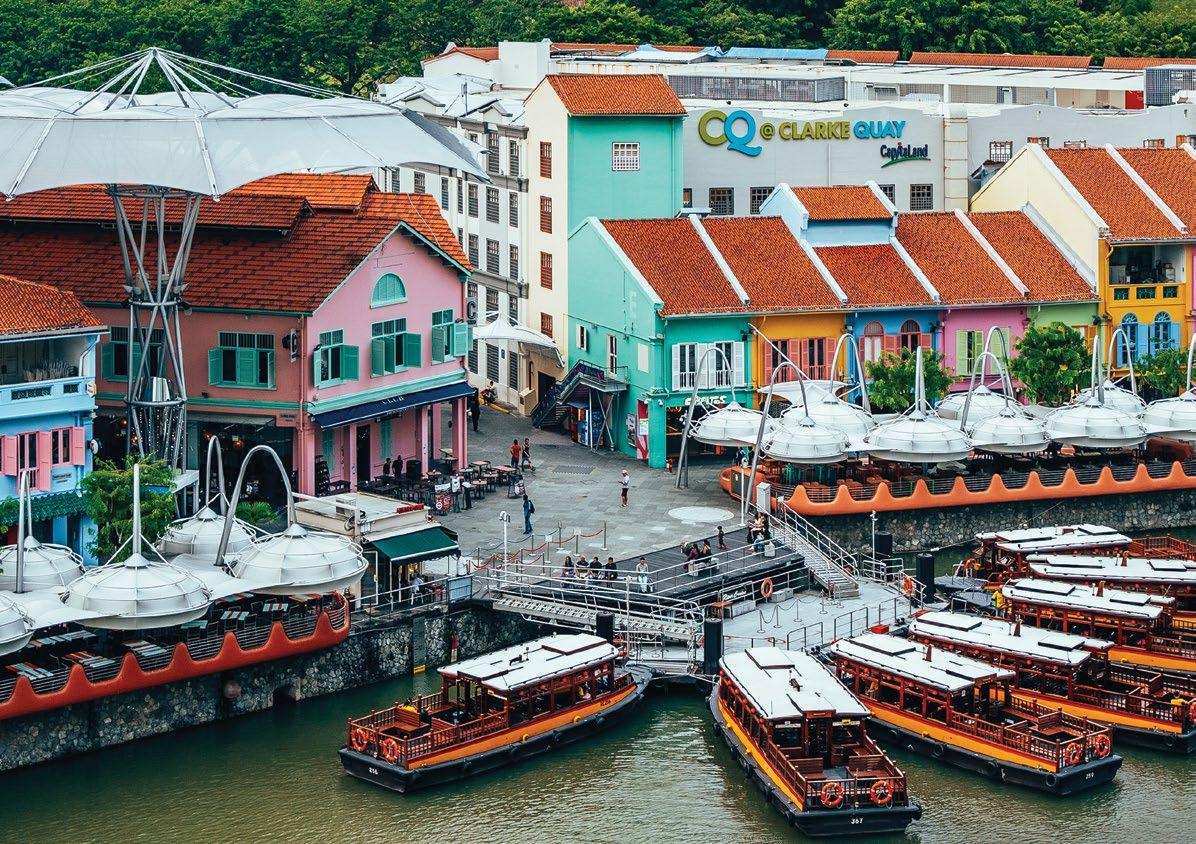

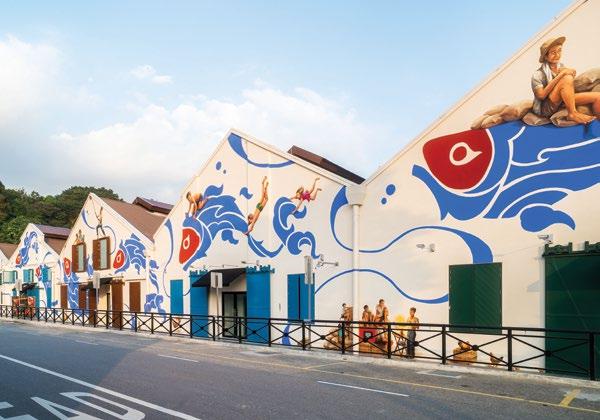




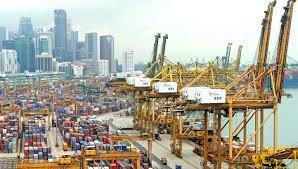



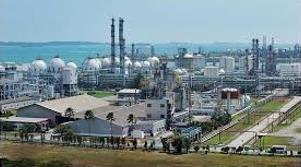


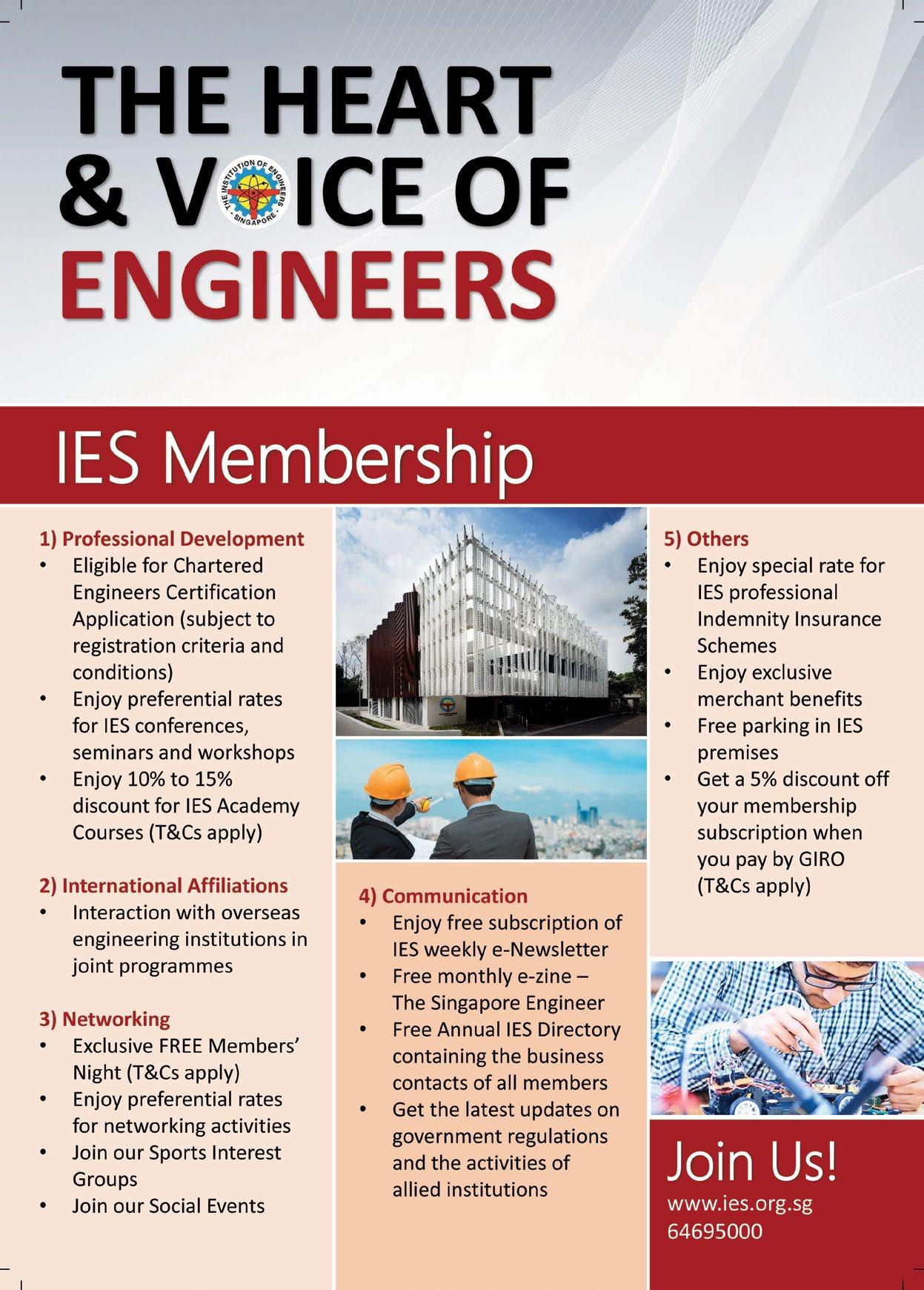
11 Ushering in a new era of CQ @ Clarke Quay
The riverside lifestyle hotspot relaunches as a vibrant day-and-night destination.
17 Workplace fatal and major injury rates for 2023 at record low
The achievement reflects the collective efforts of the government, various organisations and workers.
22 Launch of NEC4 contract for construction and engineering projects in Singapore
The benefits include effective time and cost control, risk management and project management.
24 Elevating students’ appreciation through real-world applications
Connecting the theoretical to practical usefulness.
President Er. Chan Ewe Jin
Chief Editor T Bhaskaran t_b_n8@yahoo.com
Publications Manager Desmond Teo desmond@iesnet.org.sg
Publications Executive Nuraini Ahmad nuraini@iesnet.org.sg
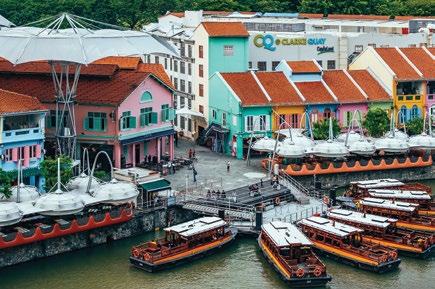
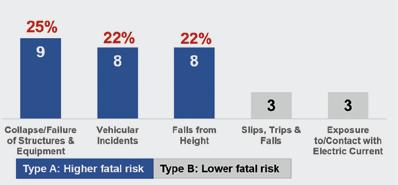
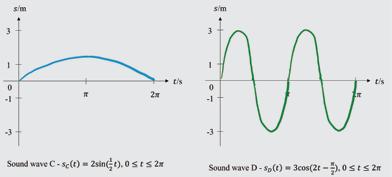
Editorial Panel
Dr Victor Sim
Dr Chandra Segaran
Dr Ang Keng Been
Dr Aaron Sham
Mr Jaime Vega Bautista Jr
Mr Soon Ren Jun
Dr Alexander Wiegand
Media Representative Trevor Teh IES@mnc-link.com
Design & layout by 2EZ Asia Pte Ltd
Cover designed by Irin Kuah
Cover images by CapitaLand
by
Institution of Engineers, Singapore
Bukit Tinggi Road, Singapore 289758
6469 5000 I Fax: 6467 1108 Printed in Singapore

28 Study proves viability of urban electric construction Conditions can be created to support a smooth transition to electric construction sites and emission-free contracting.
30 Counteracting water infiltrations
The latest generation of waterproofing membranes was used in the redevelopment of the historic Castel Nuovo in Naples, Italy.
33 Supporting the construction of Eunoia Junior College Effective management of tasks through digitalisation.
34 Danjiang Bridge reaches record-breaking proportions Upon completion, it is expected to be the world’s longest, asymmetric, cable-stayed bridge.
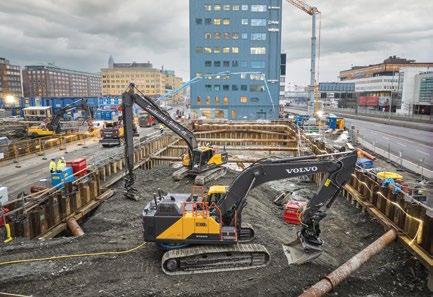


free-of-charge to IES members and affiliates. Views expressed
necessarily reflect those of the Editor or IES. All rights reserved. No part of this magazine shall be reproduced, mechanically or electronically, without the prior consent of IES. Whilst every care is taken to ensure accuracy of the content at press time, IES will not be liable for any discrepancies. Unsolicited contributions are welcome but their inclusion in the magazine is at the discretion of the Editor.
Organised by the IES M&E Engineering Technical Committee, and supported by the Singapore Civil Defence Force (SCDF) and the Fire Safety Managers’ Association Singapore (FSMAS), the annual ‘Key Amendments to Fire Code’ event was held on 15 May 2024, at HDB Hub Auditorium.
Over 400 participants gathered for the seminar, created for professionals looking to stay on top of the latest fire safety standards.
The seminar provided a comprehensive overview of significant changes to the fire code, addressing the industry’s need for current information and understanding of new standards.
It provided an avenue for discussing common consultation queries, where participants could gain clarity on challenging aspects of the fire code, to ensure a uniform application of the regulations across projects.
Additionally, the seminar shed light on common audit findings, highlighting areas where compliance often fell short, and offered guidance for improvement.
A special session on the fire safety of electrical transformers in underground structures offered targeted insights into managing these highrisk areas effectively.
A notable inclusion in the line-up was a presentation on the implementation of fire-smoke dampers, including compliance with the SS 333 standard to issuance of the Certificate of Conformity (COC).
The seminar served as an essential conduit for professionals to enhance their understanding, improve submission quality and ensure adherence to the latest fire safety standards.
Fire safety and building design experts, including consultants, fire safety officers, and engineers gathered to hear MAJ Muhammad Izwan Bin Ibrahim, Senior Consultant

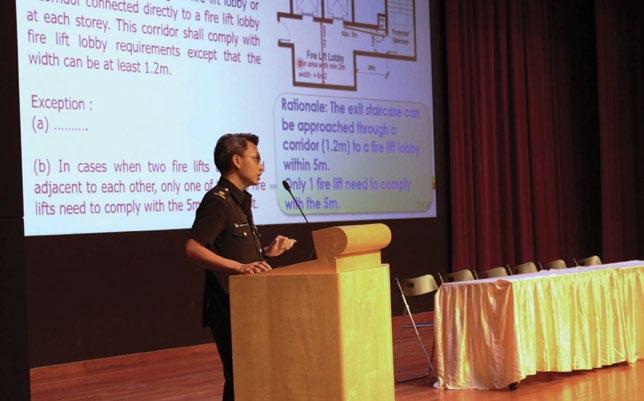
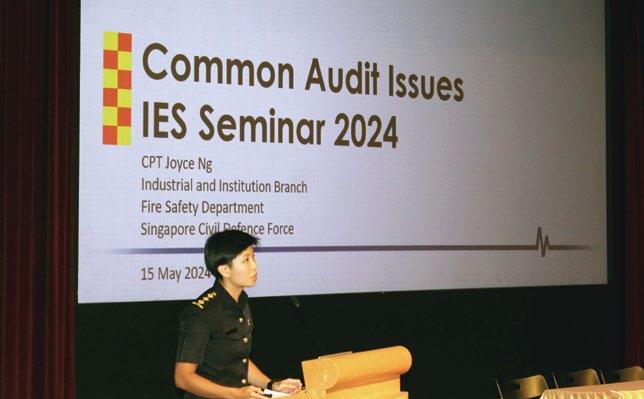

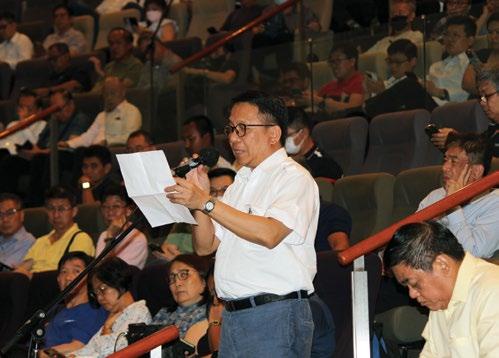
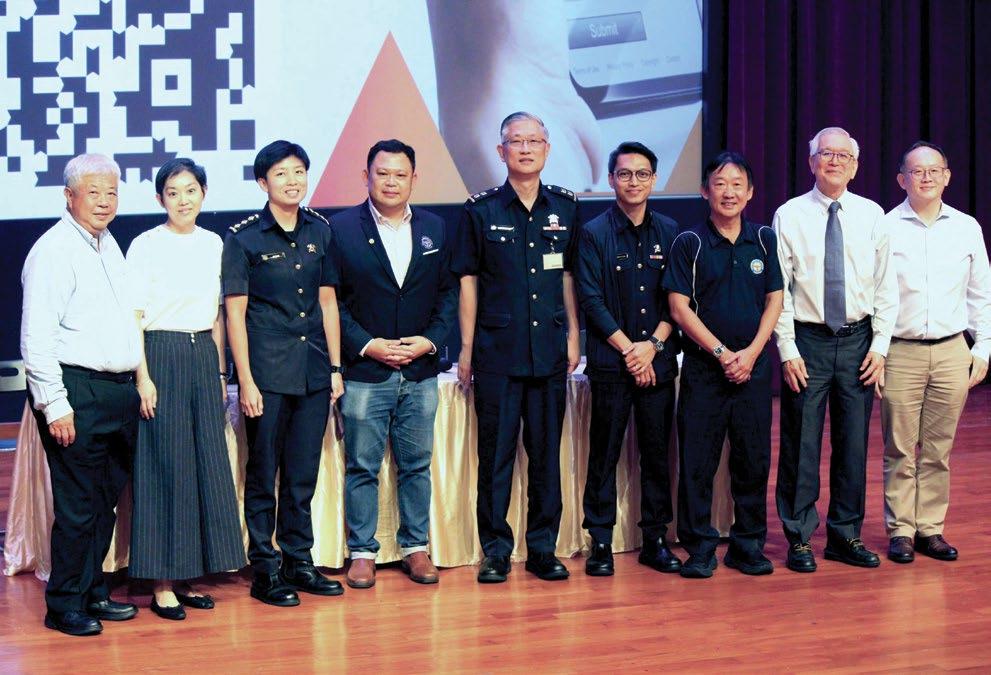
at SCDF, break down updates to the Fire Code within the Code of Practice for Fire Precautions in Buildings, and everything from submission processes for SCDF approval to the responsibilities of Qualified Persons (QPs), as well as interpret clauses of the Fire Code.
SCDF Consultant CPT Joyce Ng provided the audience with common audit findings, focusing on
typical non-compliances in commercial and industrial projects, and highlighting key areas for QPs to improve the quality of their submissions.
Er. Simon Lee, Director, Bescon Consulting Engineers Pte and IES M&E Engineering TC Chairman, highlighted the fire risks for electrical transformers in underground structures and the mitigation measures to
be taken to ensure fire safety.
Er. Yee Poh Kin, Principal, New Universal Solution and VP, Institution of Fire Engineers, Singapore, shared valuable insights on the critical role of fire-smoke dampers in buildings.
IES specially thanks the speakers, moderator and the audience, for their participation in the seminar and panel discussion.
PUB, Singapore’s National Water Agency, snagged two awards at the Global Water Awards 2024, held in London, recently. The Global Water Awards are announced annually by Global Water Intelligence (GWI), to recognise the most important achievements in various water sectors.
Singapore’s Changi Water Reclamation Plant (WRP) was conferred the ‘Wastewater Project of the Year’ award, while the Jurong Island Desalination Plant (JIDP) clinched the distinction award in the ‘Desalination Plant of the Year’ category.
Mr Ong Tze Ch’in, PUB’s Chief Executive, said, “We are grateful for this recognition by the global water industry, as it affirms PUB’s continuing journey of innovation and excellence. With climate change, we will need to continue improving our water infrastructure and operational efficiency.”
Used water treatment and desalination are key elements of Singapore’s integrated water management. Singapore has effectively closed the water loop through the treatment of used water for the production of NEWater, and through desalinating seawater. NEWater and desalinated water, Singapore’s 3rd and 4th National Taps, introduced in 2002 and 2005, respectively, are weather-resilient sources that strengthen Singapore’s water security amidst the challenges of climate change.
Changi WRP, one of the largest and most advanced water reclamation facilities in the world, was conferred the ‘Wastewater Project of the Year’ award, in recognition of its innovative practices in reducing its physical footprint.
This is PUB’s second win in this category, following the Ulu Pandan Integrated Validation Plant’s success in 2018.
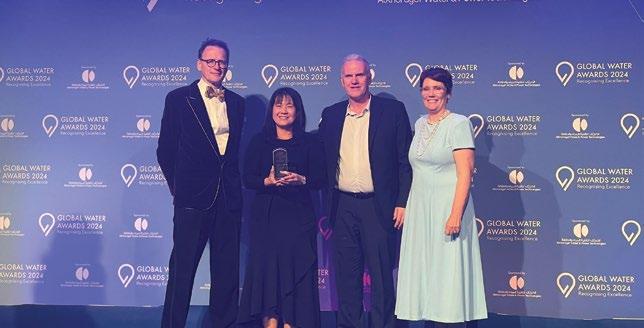
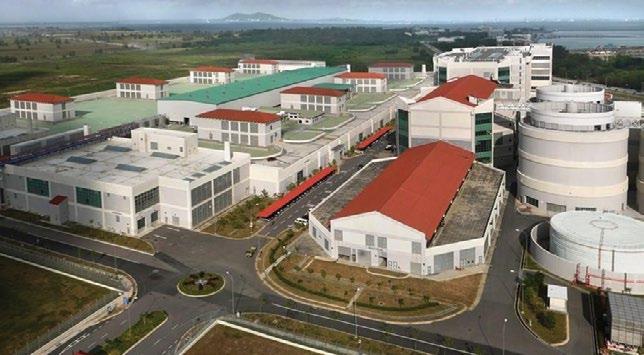
Commissioned in 2008, as part of the Deep Tunnel Sewerage System (DTSS) Phase 1 project, the plant boasts a compact design and innovative features, as it was constructed partially underground. The used water treatment facilities at Changi WRP are stacked to optimise space, allowing it to occupy a third of what conventional WRPs would require.
Changi WRP’s Phase 2 expansion project, which is scheduled for completion by end-2024, will increase the plant’s used water treatment capacity from 176 million gallons
per day (mgd) to 246 mgd – the equivalent of more than 440 Olympic-sized swimming pools. The increase in capacity will be achieved through the construction of a fifth treatment train, a separate wet weather facility (WWF) and the installation of advanced membrane bioreactor (MBR) equipment.
Upon completion, Changi WRP will be Singapore’s largest MBR facility. MBR is a 3-in-1 solution that combines conventional bioreactors, secondary sedimentation tanks and microfiltration/ultrafiltration, in a single stage.
This allows downstream NEWater processes to be simplified with just reverse osmosis (RO) membranes and ultraviolet disinfection, negating the need for microfiltration. The filtrate obtained from MBR is also of higher quality, improving the overall lifespan of RO membranes and producing less biosolids. This will help PUB achieve a more efficient and reliable used water treatment process, while also optimising the subsequent NEWater treatment process.
Jurong Island Desalination Plant Singapore’s latest and fifth desalination plant, the Jurong Island Desalination Plant (JIDP), which opened in 2022, picked up the distinction award in the ‘Desalination Plant of the Year’ category, losing out to Saudi Arabia’s 3A Jubail Independent Water Plant, for the top award.
JIDP’s co-location with the Tembusu Multi-Utilities Complex (TMUC) allows it to tap on potential synergies and the sharing of resources with the power plant in TMUC. JIDP draws electricity directly from the adjacent power plant at TMUC, improving process efficiency and reducing the energy consumption, by 5%, as compared to conventional desalination plants, translating to annual energy savings sufficient to power nearly 1,000 HDB households.
Modular systems were created in different areas of the desalination process and prefabricated off-site to simplify and speed up the completion of JIDP. The operations at the plant are highly automated, to significantly reduce operator workload, allowing for more streamlined operations that can be controlled from the main control room. JIDP also incorporates advanced water treatment equipment and membrane technologies such as dissolved air flotation, ultra-filtration, and reverse osmosis, enabling the plant to further optimise the desalination process.
Global Water Intelligence
Global Water Intelligence researches and publishes business data and information about water markets worldwide.
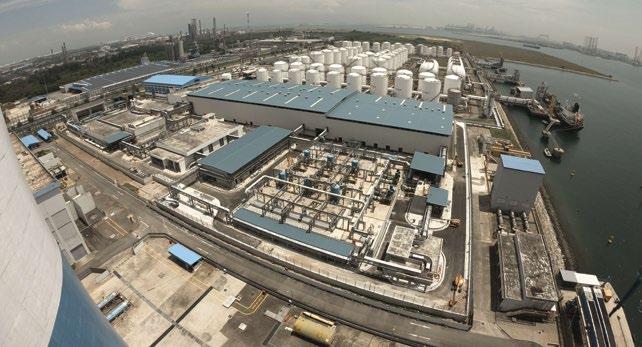
Water Company of the Year
WINNER – SUEZ
DISTINCTION – Gradiant
Desalination Company of the Year
WINNER – Acciona
DISTINCTION – Saline Water Conversion Company (SWCC)
Water Technology Company of the Year
WINNER – Grundfos
DISTINCTION – Siemens
Breakthrough Technology Company of the Year
WINNER – Aqua Membranes
DISTINCTION – Purecontrol
Public Water Company of the Year
WINNER – Saudi Water Partnership Company, Saudi Arabia
DISTINCTION – New York City Department of Environmental Protection, USA
Desalination Plant of the Year
WINNER – Jubail 3A IWP, Saudi Arabia
DISTINCTION – Jurong Island Desalination Plant, Singapore
Water Project of the Year
WINNER – Poblacion WTP, Philippines
DISTINCTION – San Fernando Groundwater Treatment Program, USA
Wastewater Project of the Year
WINNER – Changi WRP
Expansion, Singapore
DISTINCTION – Umm Al Hayman WWTP, Kuwait
Smart Water Project of the Year
WINNER – Dubai Hydro Insight, UAE
DISTINCTION – Lahaina emergency sewer assessments, USA
Water Reuse Project of the Year
WINNER – ADSWS Recycling Transformation, UAE
DISTINCTION – Santa Monica Sustainable Water Infrastructure Project, USA
Industrial Project of the Year
WINNER – Slaughterhouse wastewater treatment, Saudi Arabia
DISTINCTION – NMDC ZLD plant, India
Water Stewardship Programme of the Year
WINNER – Intel water conservation and restoration
DISTINCTION – Danone Aguascalientes programme, Mexico
Net Zero Carbon Champion
WINNER – Xylem DISTINCTION – Scottish Water
A JTC development, LaunchPad @ one-north, an innovator’s playground for new solutions, is set to host Singapore’s first-ever co-living train hotel, featuring the adaptive reuse of a decommissioned SMRT train carriage into a boutique co-living hotel. This new hospitality concept is the creation of local startup, Tiny Pod, and will be piloted with the support of JTC.
The co-living train hotel will incorporate a total of eight rooms, each equipped with an attached bathroom. Additionally, LCD panels mounted inside the driver’s compartment will depict real-life footage of the train’s earlier journey through the tunnel, creating an immersive experience for guests.
The train hotel will be located at the car park next to Block 69 Ayer Rajah Crescent. A public recreational green space will be developed beside the co-living train hotel. Integrated with food and beverage vending machines and bicycle racks, this new amenity node will also incorporate repurposed train chairs as outdoor public benches. Renovation works commenced in March 2024, with the co-living train hotel anticipated to be operational in September 2024.
Recognising the value of being in an ecosystem of like-minded startups within LaunchPad @ one-north, Tiny Pod has leveraged this opportunity to partner with local start-up, Igloo Home, for the hotel’s smart lock system to enhance the co-living train.
Tiny Pod’s co-living train hotel project is an extension to its pop-up shipping container hotel at LaunchPad @ one-north, which was launched in 2020. Since then, Tiny Pod’s shipping containers have expanded to urban and public spaces at Gardens by the Bay and Haw Par Villa.
“In today’s market, where consumers prioritise eco-conscious choices, pop-up hotels are swiftly emerging as a lucrative niche. Our

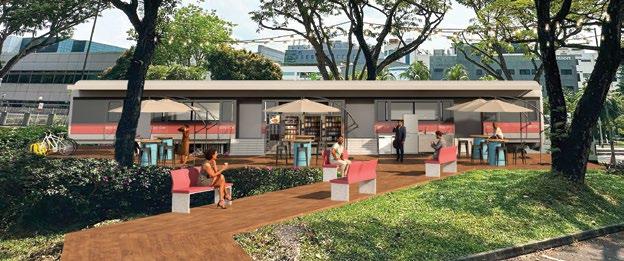
endeavour taps into this trend and exemplifies a fusion of profitability and sustainability. By transforming underutilised spaces into unique accommodation experiences, we unlock new revenue streams and minimise our environmental footprint,” said Mr Seah Liang Chiang, Founder & CEO, Tiny Pod Pte Ltd.
“This endeavour aligns seamlessly with evolving consumer preferences, where conscientious travellers seek authentic and eco-friendly alternatives. With the support of our partners, JTC, LTA, MTI and STB, and the growing momentum of eco-conscious tourism, this project demonstrates our commitment to catalyse positive change within the industry, while delivering memorable experiences for our guests,” he added.
Ms Yap Eai-Sy, JTC’s Director for New Estates Business Development and Marketing Division said, “At LaunchPad, we have curated an ecosystem of players for startups like

Tiny Pod to collaborate, co-create as well as validate new concepts and business models. Building on the success of its shipping container hotel testbed, Tiny Pod’s co-living train is a natural progression for sustainable hospitality solutions through adaptive reuse. It is also an innovative option to cater to the demand for short-term accommodation in one-north.”
The Land Transport Authority (LTA) will step up efforts to facilitate Walk, Cycle, Ride journeys.
First, LTA will expand its Friendly Streets initiative to more towns. Second, LTA will improve first-andlast-mile connectivity with more commuter infrastructure. These two initiatives, which are also in support of Age Well SG, will receive additional funding of around SGD 1 billion, over the next decade.
LTA will additionally fund two new road repurposing projects to prioritise road space for pedestrians and cyclists. These enhancements aim to create safer, more inclusive public spaces, and encourage active and sustainable modes of transport.
Located at areas with high pedestrian flow and close to key amenities, Friendly Streets was announced in the Ministry of Transport’s Committee of Supply debate in 2023. This initiative started with five pilot locations and aims to make walking and cycling commutes within the neighbourhoods safer, more inclusive and comfortable. The locations are Ang Mo Kio, Bukit Batok West, Tampines, Toa Payoh and West Coast.
LTA has started works at Ang Mo Kio, Bukit Batok West and Tampines, and works for the remaining pilot locations will commence in the coming months.
Encouraged by the strong community support for the five pilots, LTA will expand the Friendly Streets initiative to all HDB towns by 2030, as well as to private estates with high-activity areas and key amenities nearby. The next phase of the Friendly Streets initiative will cover 10 more towns, in the following locations – Bedok, Buangkok, Bukit Panjang, Choa Chu Kang, Holland/Buona Vista, Jurong East, Pek Kio, Punggol, Sembawang and Tiong Bahru/Havelock.
LTA will start engaging the community and relevant stakeholders in these
towns, later this year, to determine the specific locations and Friendly Streets features to be implemented.
LTA will enhance commuter infrastructure which is aimed at improving barrier-free access and making walking to key public transport nodes more convenient and comfortable. These enhancements provide residents, especially seniors, with improved access to amenities and public transport nodes, and encourage them to lead more active lifestyles and stay socially connected.
Planned commuter infrastructure enhancements over the next decade include:
• Upgrading and implementing senior-friendly features at more bus stops, such as additional seats with arm and back rests, as well as ensuring wheelchair accessibility.
• Building more covered linkways to connect MRT stations to more Friendly Streets and some key amenities nearby, that are largely within an 800 m radius, for more comfortable and convenient walking experiences.
• Retrofitting more pedestrian overhead bridges with lifts, to provide barrier-free access, especially those near public transport nodes and healthcare institutions.
LTA has been retrofitting lifts at pedestrian overhead bridges, since 2013. Currently there are 87 existing pedestrian overhead bridges with lifts. This effort is prioritised for locations that are expected to benefit a high number of seniors and commuters with mobility challenges, such as for pedestrian overhead bridges near public transport nodes and healthcare institutions.
New road repurposing projects Road repurposing will continue to
enhance the Walk, Cycle, Ride experience and facilitate smoother connections between surrounding amenities. Last year, LTA announced plans to pedestrianise an 80 m-long stretch of road along Choa Chu Kang Terrace and an 18 m-long stretch at Yung Sheng Road. Works are ongoing at these locations and are slated for completion by end-2024.
This year, LTA will embark on two more road repurposing projects – at Zion Road and Sims Place.
LTA will repurpose up to two of the five to six road lanes along Zion Road (around 700 m, between River Valley Road and Ganges Avenue). The repurposed space will feature a widened footpath and a new cycling path to connect Zion Road to the Alexandra Park Connector. It will also enable LTA to expand the existing bus shelter opposite Great World City as well as provide sheltered connectivity for commuters to Zion Riverside Food Centre.
At Sims Place, LTA plans to repurpose a 300 m road stretch fronting Sims Vista Market and Food Centre, from four road lanes to two lanes. There will be space for a widened footpath and a new cycling path. LTA will also provide sheltered connectivity across Sims Place to the market and food centre.
These two projects are expected to commence later this year with completion slated for 2026.
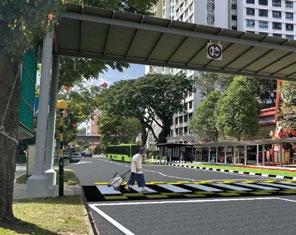
The 2024 edition of INTERMAT, the show for sustainable construction and technologies, was held from 24 to 27 April 2024, at Paris Nord Villepinte, Paris, France.
With its redesigned offering and format, INTERMAT 2024 attracted 127,500 visitors, 21% of whom came from 130 countries outside France. A total of 1,065 exhibitors, including 68% from outside France, welcomed a high-quality visitor audience, keen to witness the industry’s drive towards environmental and technological progress.
The show acted as a business-conducive catalyst, with the presence of a large proportion of decision-makers. A third of the visitors came with investment plans to accelerate the low carbon and digital transition of construction projects.
INTERMAT 2024 was also the point of convergence for professionals who came in search of innovation to address climate-related and societal challenges faced by the construction industry.
The exhibition was opened by the chairmen of the five main construction trade associations in France, who signed the manifesto ‘4 keys to support the decarbonisation of construction equipment’.
Adopting the right energy for each use, saving energy, raising stakeholder awareness of CSR, and improving the safety and appeal of jobs in construction, were at the heart of some highly productive debates staged in the new Industry Forum and Academy spaces.
Talks, round tables and special features gave an opportunity to visitors and, in particular, to the 1,400 young people in attendance, to gain an insight into the major issues in the sector and help accelerate the green and digital transitions.

International innovation on show
This edition was marked by the representation of major international construction companies. The main countries represented by the exhibitors included Belgium, the Netherlands, Italy, Germany, the UK, Finland, North African countries and Türkiye. The ReBuild Ukraine talk addressed all the themes essential for the reinforcement of the Ukrainian nation through reconstruction.
At the 2024 show, the INTERMAT Innovation Awards provided further evidence of the powerful innovation dynamic in the design and manufacture of equipment and machinery to support energy transition, digitalisation and safety.
The New Technologies and Energies hub and the Start-up Village showcased technology and equipment incorporating new, alternative or renewable energy sources (biofuel, electric, hydrogen), virtual and digital engineering, energy storage solutions and autonomous vehicles.
The multiple machinery demo zones, both outdoors and on stands, gave visitors a chance to discover the momentum of the latest developments by manufacturers, for better safety, productivity and energy efficiency.
The exhibition zone and educational forum focussing on the low carbon transition of the concrete sector attracted the attention of nearly one in two visitors. The INTERMAT Innovation Awards rewarded the sector’s efforts to reduce the carbon impact of materials, processes, technology and equipment.
The 2024 edition was a tradeshow redesigned in terms of format and offering, and revolving around four pillars – Innovation, Energies, New equations, and Commitments. Over and above the valuable business opportunities, the show reasserted its ambition of bringing together and sharing with the entire ecosystem, the wealth of innovation in support of decarbonisation.
Exhibitors were able to meet many visitors and help them bring their purchasing plans to fruition. The 2024 show succeeded in its goal of collectively providing novel responses to the questions from professionals.
The next edition of INTERMAT will be held in April 2027.
The riverside lifestyle hotspot relaunches as a vibrant day-and-night destination.
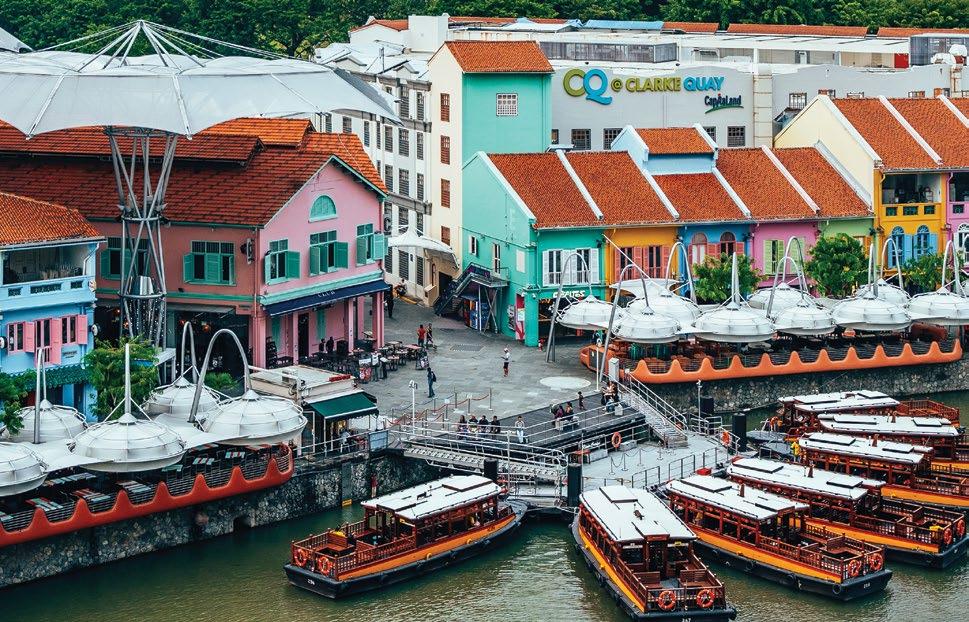
Nestled along the Singapore River at the fringe of Singapore’s Central Business District, CQ @ Clarke Quay is a unique conserved landmark, seamlessly blending heritage with modernity.
The rejuvenated CQ @ Clarke Quay was officially unveiled recently, marking the culmination of an asset enhancement initiative (AEI) that has transformed the development into an iconic, riverfront dayand-night destination.
Generating a net lettable area of approximately 290,000 ft2, the development comprises sheltered internal streets (Read Street & Clarke Street); a riverfront promenade with outdoor refreshment areas; three blocks of shophouses (Blocks A, D and E), two blocks of warehouses (Blocks B and C); and a multi-storey carpark block with 406 carpark lots and 23 motorcycle lots.
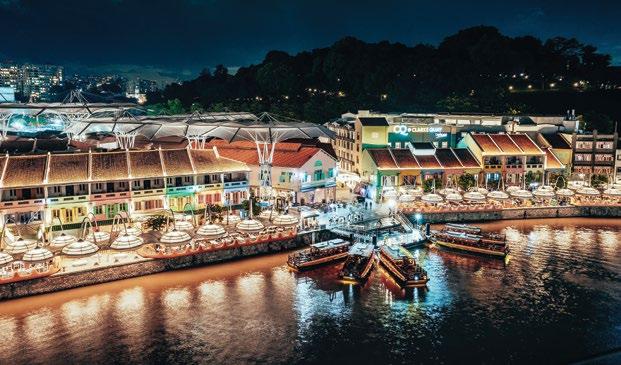
CQ @ Clarke Quay has three distinctive zones – The Warehouses (Block B), The Riverfront (Blocks A and D) and The Circuit (Blocks C and E).
The Warehouses (Block B) offers an exciting blend of retail, lifestyle and
F&B concepts, in conserved godowns.
The Riverfront (Blocks A and D) features riverside dining in an alfresco or heritage shophouse setting.
The Circuit (Blocks C and E) showcases high-energy concepts, entertainment and F&B establishments.
Owned by CapitaLand Integrated Commercial Trust (CICT) and managed by CapitaLand Investment Limited (CLI), CQ @ Clarke Quay is now a vibrant hub of excitement and entertainment, with an expanded range of day activities and nightlife attractions for locals and tourists.
With the completion of the AEI, which commenced in August 2022, CQ @ Clarke Quay has about 60 dining, retail and lifestyle concepts, achieving a strong occupancy of 93% to-date. CQ @ Clarke Quay has refreshed its tenant mix by introducing more than 50% new concepts, comprising international and homegrown brands. This dynamic transformation is in tandem with the ongoing urban renewal of the Singapore River precinct to incorporate more leisure amenities as well as residential and hospitality developments.
The ceremony to unveil CQ @ Clarke Quay was graced by the Guest-ofHonour, Ms Low Yen Ling, Minister of State for Ministry of Culture, Community and Youth, and Ministry of Trade & Industry.
Representatives from CapitaLand, industry partners, tenants, media and members of the public, were present at the event.
Guests were treated to a spectacular showcase of entertainment and cultural experiences, curated to delight visitors. This included a drone show that traced the rich tapestry of CQ @ Clarke Quay’s history, from its origins as a bustling riverport trading district to the vibrant riverfront lifestyle destination it has become today.
Mr Tony Tan, CEO of the manager of CICT, said, “Guided by our value creation strategy, we regularly review our asset plans to optimise and future-proof our properties through AEIs. The repositioning of CQ @ Clarke Quay as a vibrant day-andnight destination with more diversified offerings will further strengthen the resilience of our portfolio. We expect CQ @ Clarke Quay to see strong demand from tourists and locals as the Singapore River
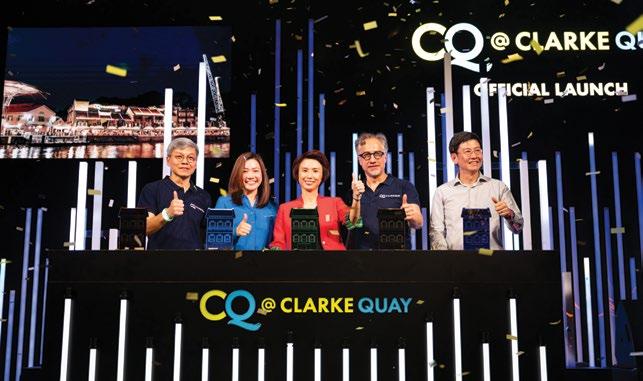
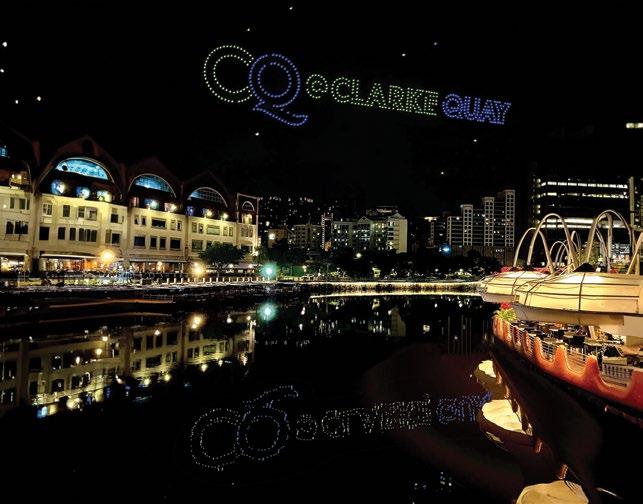
precinct evolves.”
“With the upgraded sustainability features at the property, CQ @ Clarke Quay’s green rating has been elevated to Green Mark GoldPLUS With this, all 21 properties in our Singapore portfolio have achieved a minimum rating of Green Mark Gold by the Building and Construction Authority,” he added.
Mr Chris Chong, CEO, Retail & Workspace (Singapore & Malaysia), CLI said, “Through strategic enhancements and active placemak-
ing efforts, we have transformed CQ @ Clarke Quay into a dynamic and immersive environment for visitors to enjoy, solidifying its position as a day-and-night destination for leisure, dining and entertainment. Beyond preserving the rich heritage of Clarke Quay, we have injected fresh energy into the precinct, integrating new retail and lifestyle experiences, including the introduction of pet-friendly amenities that cater to the diverse preferences of our visitors.”
New concepts at CQ @ Clarke Quay include FairPrice Finest Clarke Quay which offers a wide range of products curated in collaboration with Singapore-based partners. The Grocer Food Hall, a food experience zone, offers ‘You Pick, We Cook’ services as well as curated cocktails infused with local flavours that are exclusive to CQ @ Clarke Quay.
Another new concept is Swee Lee Clarke Quay, which devoted approximately 60% of the repurposed warehouse unit to curate an experiential and community space. The musical instrument store houses a bar and café, an artist lounge, vinyl listening stations, a creator corner with music editing set-ups and a large hall that doubles as a dining space and performance venue. This is Swee Lee’s largest outlet in Singapore.
Opening in 3Q 2024, wellness enthusiasts can embark on a holistic fitness journey with LAVA, offering three exciting new concepts – Reformer Pilates, Kickboxing, and Electro Muscle Stimulation training.
Visitors looking for day to night activities can check out Home Singapore. By day, Home Dawn welcomes visitors with delicious brunch specialties. At sundown, Home Dusk transitions into an electrifying live music lounge. Alongside these are newly added dining establishments such as IL Clay Supper Club, a Neapolitan-style pizzeria and bar concept by renowned Naples-born chef Ciro Sorrentino, and Jules, a French bistro by Chef Laurent Brouard.
There are also a variety of latenight entertainment offerings. The line-up includes new Mexican taqueria Señor Taco, offering mescal and handcrafted agave cocktails, Mexican cuisine and Latin live band; arcade bar Level Up as well as homegrown icon Zouk and K.STAR Karaoke which features 22 futuristic-themed rooms. Along the riverfront are live music bars with international cuisine, like Chupitos, Cuba Libre Café & Bar, Little Saigon, Octapas by El Mesa, Simply Retro and Warehouse.
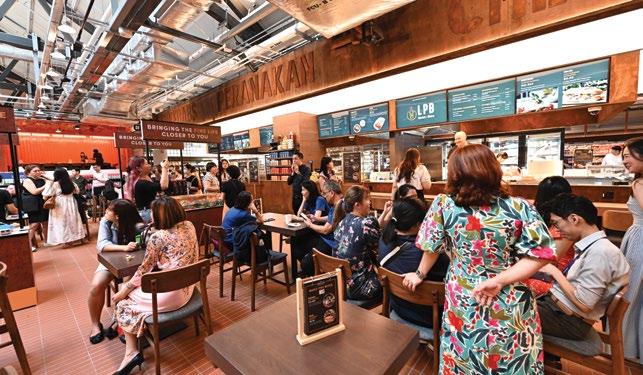
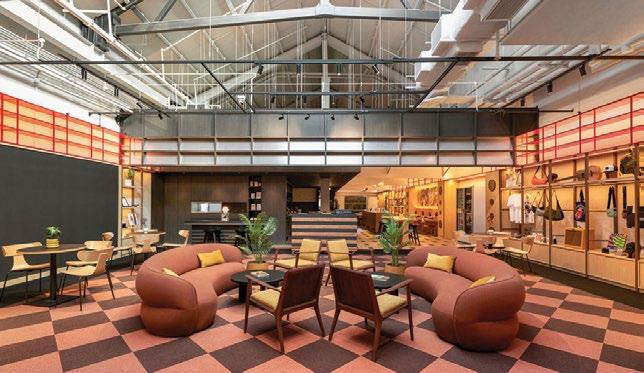
Beyond the diverse array of dayand-night options, CQ @ Clarke Quay has also unveiled a comprehensive suite of pet-friendly amenities, catering to the needs of valued visitors and their furry companions. These amenities include wellplaced pet hydration bays, waste bins and designated pet parking zones, providing convenience to visitors. Furthermore, pet owners can enjoy dining at a selection of eight pet-friendly establishments along the picturesque riverside, each labelled with pet-friendly logos for easy identification.
CQ @ Clarke Quay will also be unveiling the Fort Canine Swimming Club in 3Q 2024, which provides grooming services, an active daycare programme and curated ame-
nities tailored for the ultimate canine experience.
CQ @ Clarke Quay has the largest number of different types of heritage warehouses and shophouses in the city centre in Singapore.
A key focus of the AEI was to preserve the rich heritage and cultural legacy of CQ @ Clarke Quay, while enhancing it with modern and exciting offerings. Seven warehouses have been restored by preserving their godown typology while adorning them in new colours.
As a conserved heritage site, concerted efforts were made to profile CQ @ Clarke Quay’s rich history.
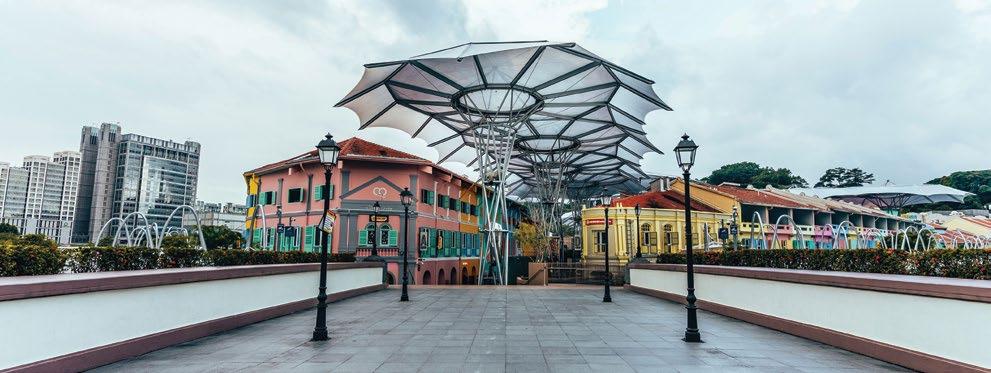
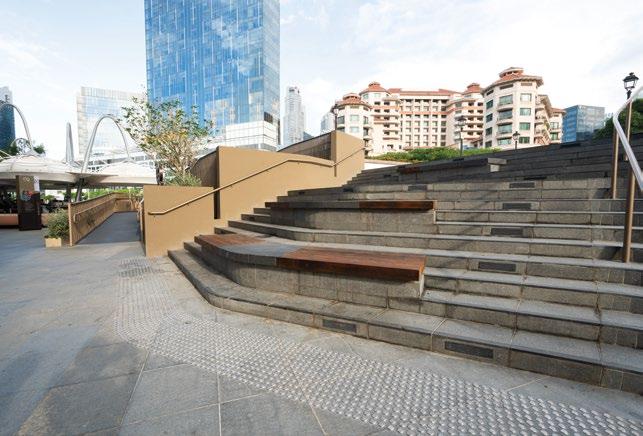

The new arrival canopy, made of lightweight ethylene tetrafluoroethylene (ETFE), integrates with the Angel structures. The new CQ @ Clarke Quay logo, which is prominently featured, is visible along River Valley Road and across, at Fort Canning Hill.
Along the Singapore River, the new Read Bridge landing has a new accessibility ramp with lookout points and upgraded steps that double up as seats, paying tribute to the Read Bridge’s historical role as a communal space for storytelling.
The steps of the ramps are clad, in the Read Bridge’s signature Bronze Age finish, with upcycled wood
pieces, taken from the last two Twa Kows (historical cargo vessels) that were previously located at CQ @ Clarke Quay.
The historical preservation and modern functionality results in a one-of-a-kind space, offering an exciting blend of retail, lifestyle and F&B concepts, in a collection of seven, side-by-side, conserved godowns. Heritage jack roofs were also reinstated and glass skylights were incorporated to draw natural light in. The bright and naturally-lit interiors are spacious and come with high ceilings. The revitalised space provides a setting of heritage
charm with contemporary amenities.
Fronting the restored The Warehouses’ facade is the ‘Fire Fish’ mural, a modern myth, uniquely created by homegrown artists Yip Yew Chong and tobyato, which is inspired by Clarke Quay’s heritage as a Teochew enclave.
The mural features the firewood trade in the area, distinctive red and white Teochew bumboats that once lined the Singapore River, and iconic storytellers entertaining the coolies on Read Bridge. The walkway was also widened to improve accessibility. Visitors can now also access the units at Block B from Tan Tye Place.
A heritage building with distinctive tiled roof and decorative features, known as the Riverhouse (Lian Yi Xuan in Chinese), is a feature landmark at CQ @ Clarke Quay. The removal of the dining platform resembling a lilypad and eight bluebell-shaped canopies created a new scenic resting stop for visitors along the riverfront promenade.
The connection with the river is re-established with the removal of some of the lilypads and replaced by historically-referenced new balustrades in the signature Bronze Age finish. Riverside dining is enhanced as the bluebell-shaped canopies have been refreshed with new Polytetrafluoroethylene (PTFE) membranes and high-volume-lowspeed (HVLS) fans, to improve thermal comfort. The timber deck of the lilypads were also refurbished. Lighting within these riverside structures is designed to enhance the ambience for diners.
Existing Angel canopies have been upgraded with ETFE membranes to reduce solar heat gain and optimise daylight conditions. Adding to the sustainability features are new omni-directional fans which lower the environmental temperature, through evaporative mist cooling, reducing energy consumption.
New barriers at the outdoor refreshment areas were introduced, with design patterns coherent to each zone’s identity.
Heritage panels and bronze plate tiles, strategically positioned throughout the area, recount the enthralling history of the Singapore River and Clarke Quay precinct, serving as educational elements for visitors as they explore the area’s rich history.
The Peddlers Walk has been refreshed with a new lobby portal and directional signage to improve wayfinding. In addition, the bronze heritage plaques and terracotta colour flooring are a nod to the area’s past



as back-to-back shophouses. Other features include a heritage airwell and jagged walls. Timber stools and seats, incorporating the original wood pieces from the Twa Kows, serve as resting spots.
A new lighting concept was introduced to add vibrancy to the development. To celebrate the rich heri-
tage along the riverfront promenade and internal streets, key architectural elements of the building façade were highlighted. The original cool lighting of the Angel structures and bluebell-shaped canopies were changed to warm lighting to complement the heritage buildings. In addition, the latest LED lighting that is energy-efficient and reduces maintenance requirements has been adopted.
Another key enhancement at the revamped CQ @ Clarke Quay is its focus on sustainability. Approximately 34% of the AEI cost was allocated towards improving operational efficiency and integrating sustainable building features.
One notable improvement is the reduction of daytime ambient temperature, which enhances the thermal comfort of the property’s inner streets.
To achieve this, existing Angel canopies have been upgraded with advanced ETFE membranes that optimise daylight conditions and reduce solar heat gain, by 70%, along all internal streets.
Further, the iconic bluebell-shaped canopies along the river promenade were fitted with enhanced Polytetrafluoroethylene (PTFE) membranes to improve thermal comfort.
New omni-directional fans were installed to further enhance air circulation, while reducing fan energy consumption by approximately 50%. Equipped with nozzles to release evaporative cooling mists, these new fans lower ambient temperature by approximately 2 °C, thereby reducing the urban heat island effect.
Further, upgrading of the chillers has contributed to a 30% improvement in energy efficiency, achieving the industry’s best practice of less than 0.6 kW/RT.
These green features have collectively enabled CQ @ Clarke Quay to achieve 1.03 million kilowatt-hours (kWh) per year of energy savings, equivalent to the annual energy requirements for powering about 240 four-room HDB flats.
Also, the existing steel and concrete structures in the canopies have been retained. In extending the operational lifespan of these components, approximately 1,000 tonnes of embodied carbon have been potentially avoided.
With the enhanced sustainability features and improvements in energy efficiency, CQ @ Clarke Quay’s Green Mark certification by the Building and Construction Authority was elevated to Green Mark GoldPLUS
CapitaLand Integrated Commercial Trust (CICT) is the first and largest real estate investment trust (REIT) listed on Singapore Exchange Securities Trading Limited (SGX-ST) with a market capitalisation of SGD 13.3 billion as at 31 March 2024. It debuted on SGX-ST as CapitaLand Mall Trust in July 2002 and was renamed CICT in November 2020 following the merger with CapitaLand Commercial Trust.
CICT owns and invests in quality income-producing assets primarily used for commercial (including retail and/or office) purpose, located predominantly in Singapore. As the largest proxy for Singapore commercial real estate, CICT’s portfolio comprises 21 properties in Singapore (including its 45.0% interest in CapitaSpring), two in Frankfurt, Germany, and three in Sydney, Australia, with a total property value of SGD 24.5 billion.
CICT is managed by CapitaLand Integrated Commercial Trust Management Limited, a wholly owned subsidiary of CapitaLand Investment Limited, a leading global real asset manager with a strong Asia foothold.
Headquartered and listed in Singapore, CapitaLand Investment Limited (CLI) is a leading global real asset manager with a strong Asia foothold.
As at 31 March 2024, CLI had SGD 134 billion of assets under management as well as nearly SGD 100 billion of funds under management (FUM) held via six listed real estate investment trusts and business trusts, and more than 30 private vehicles across Asia Pacific, Europe and USA. Its diversified real estate asset classes cover retail, office, lodging, business parks, industrial, logistics, self-storage and data centres.
CLI aims to scale its FUM and fee-related earnings through fund management, lodging management and commercial management, and maintain effective capital management. As the investment management arm of CapitaLand Group,
CLI has access to the development capabilities of and pipeline investment opportunities from CapitaLand’s development arm.
As a responsible company, CLI places sustainability at the core of what it does and has committed to achieve Net Zero carbon emissions for Scope 1 and 2 by 2050. CLI contributes to the environmental and social well-being of the communities where it operates, as it delivers long-term economic value to its stakeholders.
Project CQ @ Clarke Quay
Location 3 River Valley Road
Owner
CapitaLand Integrated Commercial Trust
Project Manager
CapitaLand Development Pte Ltd
PROJECT CREDITS
Design Architect
META Architecture
Project Architect
Formwerkz Architects LLP
Civil & Structural Engineer
RSP Architects Planners & Engineers (Pte) Ltd
Mechanical & Electrical Engineer
J Roger Preston (S) Pte Ltd
Quantity Surveyor
Asia Infrastructure Solutions
Singapore Pte Ltd
Environmental Sustainability
Design & Green Mark
Consultant
Atelier Ten (Asia) Pte Ltd
Landscape Designer
ICN Design International Pte Ltd
Lighting Designer
Nipek Pte Ltd
Conservation Consultant
MAEK Consulting Pte Ltd
Fire Safety Engineer
IGnesis Engineering Pte Ltd
The achievement reflects the collective efforts of the government, various organisations and workers.
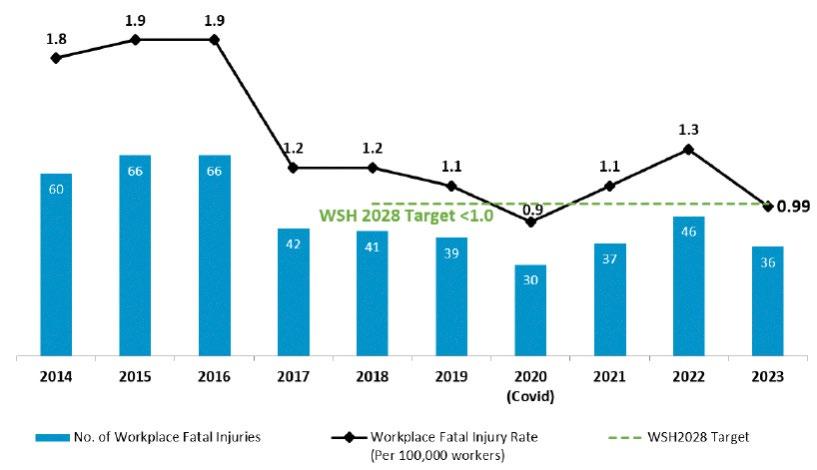
Singapore’s workplace fatal injury rate declined to 0.99 per 100,000 workers in 2023, from 1.3 in 2022. Excluding 2020, when the COVID-19 pandemic disrupted work, this is the first time the workplace fatal injury rate has fallen below 1 per 100,000 workers, which is the country’s Workplace Safety and Health (WSH) 2028 target. The workplace major injury rate also decreased to 16.1 per 100,000 workers in 2023, from 17.3 the previous year, and is the lowest recorded in the past decade.
Singapore’s 2023 WSH performance is a significant improvement from 2022, when a Heightened Safety Period was imposed. It reflects the collective efforts of businesses, industry associations, unions, workers
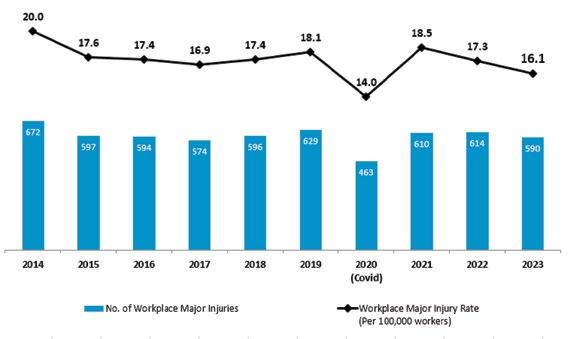
and rates (per 100,000 workers) in the past decade.
and government agencies, through the Multi-Agency Workplace Safety and Health Taskforce (MAST), to strengthen WSH ownership and culture. Only four OECD countries have achieved a workplace fatal injury rate of below 1 per 100,000 workers, consistently – the United Kingdom, Netherlands, Sweden and Germany.
Improvements in workplace fatal and major injury rates were
also seen across high-risk sectors. Construction, Manufacturing, and Transportation & Storage remained the top three contributing sectors to fatal and major injuries, although there were improvements in the Construction and Transportation & Storage sectors.
Incidents in Manufacturing rose, due to more Machinery and Struck by Falling Objects incidents. MAST has introduced targeted measures to uplift standards in the Manufacturing sector, such as the Demerit Point System. Legal duties on manufacturers and suppliers of machineries will be expanded to cover more types of machinery, to ensure they are safe when used. This new requirement will be introduced later this year.
The goal now is to sustain the WSH achievements. All stakeholders – employers, industry associations, unions, workers as well as the government – need to press on with the collective efforts to prevent workplace incidents, and ensure that Singapore remains a safe workplace for all. MAST will continue to pursue SAFE measures to drive home the safety culture in every workplace and in every employer and worker.
SUMMARY OF FINDINGS
FATALITIES
Top causes of workplace fatalities
The top causes of fatalities were Collapse/Failure of Structures & Equipment, Vehicular Incidents, and Falls from Height.
There were 36 fatalities in 2023, of which 81% arose from Type A incidents, i.e. those with a higher fatality risk such as Collapse/ Failure of Structures & Equipment, Falls from Height, and Vehicular Incidents.
Reduction in major injury numbers and rates
Slips, Trips & Falls continued to be the leading cause of non-fatal injuries.
The major injury rate decreased to a decade low of 16.1 per 100,000 workers in 2023, from 17.3 in 2022.

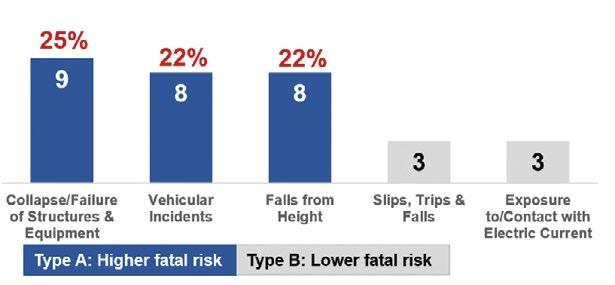
Reported minor injury rate was also stable at 606 per 100,000 workers, as compared to 596 in 2022.
Major injuries caused by Type A incidents accounted for 35% of all major injuries in 2023. Type A incidents are stronger precursors to workplace fatalities. Common root causes of these injuries included inadequate fall prevention measures, unsafe worker behaviours, inadequate WSH management systems, and failure to adhere to safety measures and procedures.
Major injuries caused by Type B incidents (i.e. those with a lower risk of fatality such as Slips, Trips & Falls, and Machinery Incidents) accounted for 65% of major injuries. Common root causes included the lack of safety measures such as failure to install non-slip flooring/ anti-slip mats on wet areas, poor housekeeping that results in obstructions or tripping hazards, failure to enforce wearing of suitable footwear, lack of or inadequate machine guarding, non-compliance with safety measures such as bypass of safety interlocks, or unsafe behaviour by workers when operating machines.
Slips, Trips & Falls (STFs) remained the top cause of non-fatal injuries, accounting for 34% of all major and 28% of all minor injuries. In 2023, there were 199 STF-related major injuries, comparable to the 200 in 2022. Machinery Incidents were the second most common cause for major injuries, accounting for 14% of all major injuries in 2023. There were 84 machinery-related major injuries in 2023, an increase from 77 in 2022. Machinery Incidents were also the second most common cause for minor injuries. There were 3,030 machinery-related minor injuries in 2023 (14% of total minor injuries), comparable to the 3,029 in 2022.
A mixed performance
There were continued improvements in Construction and Transportation & Storage, but performance in Manufacturing worsened.
Construction (18), Transportation
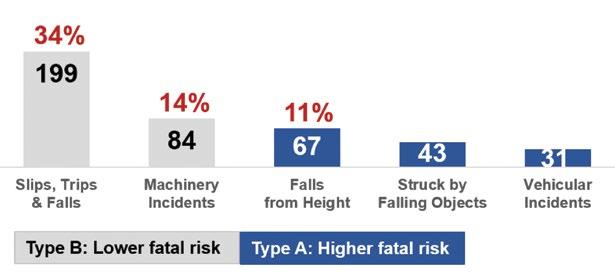
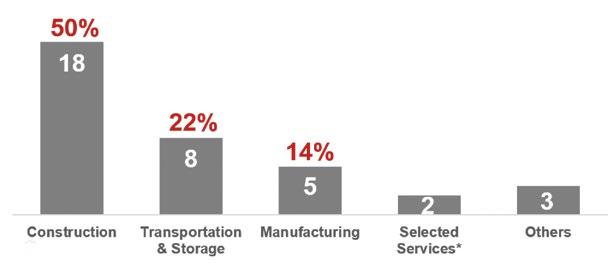

& Storage (8) and Manufacturing (5) accounted for about 86% of all workplace fatalities in 2023.
Construction’s workplace fatal and major injury rate per 100,000 workers reduced from 34.9 in 2022 to 31.9 in 2023. Similarly, in the Transportation & Storage sector, the workplace fatal and major injury rate per 100,000 workers reduced from 26.6 in 2022 to 20.4 in 2023.
However, in the Manufacturing sector, the fatal and major injury rate per 100,000 workers increased from 30.4 in 2022 to 36.3 in 2023.
Metalworking and Food & Beverages are the two main contributing industries. Metalworking’s fatal and major injury number increased from 40 in 2022 to 61 in 2023, while that of Food & Beverages reduced from 48 to 38.
Similar to previous years, the fatal and major injuries in Manufacturing were generally Type B incidents led by Machinery Incidents, followed by Slips, Trips & Falls. The common root causes remained – companies’ lack of control measures and workers’ non-compliance to safety measures.
A decrease recorded
Dangerous Occurrences (DOs) decreased, with Collapse/Failure of Structures & Equipment continuing to be the main cause.
DOs refer to prescribed incidents with the potential to cause serious damage, injury or death, such as crane collapse and explosion.
The number of DOs decreased from 27 in 2022 to 19 in 2023. Amongst the DO cases, 13 involved Collapse/Failure of Structures & Equipment and six involved Fires & Explosion.
Incidence rate rises
The annualised Occupational Diseases (ODs) incidence rate per 100,000 workers increased from 29.7 in 2022 to 33.6 in 2023. This increase was driven by the rise in reported Noise-Induced Deafness (NID) cases due to the ongoing Enhanced Workplace Health Surveillance (WHS+) efforts, which heightened awareness of reporting amongst doctors and employers, and expanded the surveillance footprint.
In 2021, MOM (Ministry of Manpower) rolled out the Enhanced Workplace Health Surveillance (WHS+), under the national 10-year WSH 2028 strategy, to minimise hazards that lead to occupational diseases, including NID.
Sixty-five percent of the Occupational Diseases were contributed by noise-induced deafness (NID), followed by work-related musculoskeletal disorders (29%) and occupational skin disease (4%). The top two industries contributing to Occupational Diseases were Manufacturing and Construction, and the top sector contributing to noise-induced deafness was Manufacturing.
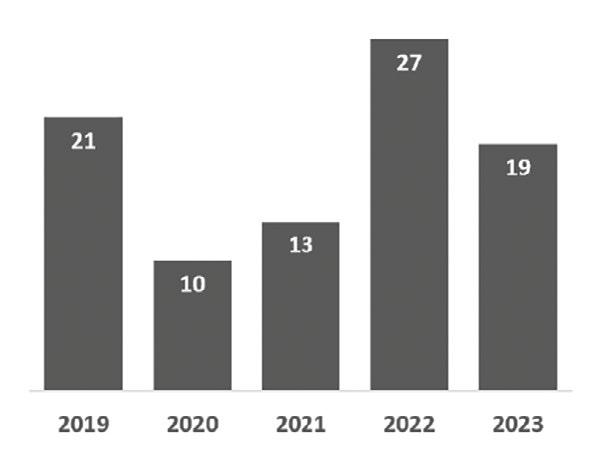

Under WHS+, companies with workers found to have higher exposures to toxic substances or noise are required to adopt upstream risk controls and put in place programmes (e.g. Management of Hazardous Substances Programmes and Hearing Conservation Programmes) that effectively reduce health risks. Companies also need to undergo third party audits to ensure their workplace health programmes are effective, and submit an audit report to MOM. MOM will
continue to increase the number of workplaces under WHS+, as well as collaborate with the WSH Council to increase awareness and implementation of workplace health programmes.

More than 70% of the global workforce, are likely to be exposed to climate change-related health hazards, and existing occupational safety and health (OSH) protections are struggling to keep up with the resulting risks, according to a new report by the International Labour Organisation (ILO).
The report, titled ‘Ensuring safety and health at work in a changing climate’, says that climate change is already having a serious impact on the safety and health of workers in all regions of the world.
The ILO estimates that more than 2.4 billion workers (out of a global workforce of 3.4 billion) are likely to be exposed to excessive heat at some point during their work, according to the most recent figures available (2020). The proportion has increased from 65.5% to 70.9% of the global workforce, since 2000.
In addition, the report estimates that 18,970 lives and 2.09 million disability-adjusted life years are lost annually due to the 22.87 million occupational injuries which are attributable to excessive heat. This is not to mention the 26.2 million people worldwide living with chronic kidney disease linked to workplace heat stress (2020 figures).
However, the impact of climate change on workers goes well beyond exposure to excessive heat, the report says, creating a ‘cocktail of hazards’ which result in a range of dangerous health conditions.
The report also explores current country responses, including revising or creating new legislation, regulations and guidance, and improving climate mitigation strategies in working environments.
The benefits include effective time and cost control, risk management and project management.
The Building and Construction Authority (BCA) announced the launch of NEC4 contract for construction and engineering projects in Singapore, at the BuildSG Leadership Engagement and Development (LEAD) Summit 2024, held at the Sands Expo & Convention Centre, Marina Bay Sands.
BCA, together with NEC, have developed a set of additional contract clauses (Y clauses) to align NEC4 contract with Singapore’s laws – as with The Building and Construction Industry Security of Payment Act 2004; The Contracts (Rights of Third Parties) Act 2001; The Insolvency, Restructuring and Dissolution Act 2018; The Prevention of Corruption Act 1960; and The Penal Code 1871.
NEC is a division under Thomas Telford Ltd, UK, the commercial arm of the Institution of Civil Engineers (ICE), the owner and developer of the NEC suite of contracts.
The NEC4 contract is the latest edition of a suite of collaborative contracts for construction and facilities management projects. The Y clauses are developed to align NEC4 with Singapore’s laws, when used for the appointment of a contractor for engineering and construction work. More information on NEC4 can be obtained from https://www. neccontract.com/
This launch marks another milestone in promoting collaborative contracting in Singapore’s built environment sector, by facilitating the use of the NEC4 contract in construction and engineering projects in Singapore, which is in line with the Built Environment Industry Transformation Map (BE ITM).
To widen the adoption of collaborative contracting in Singapore, BCA has been driving efforts which
include identifying pilot projects to use the Public Sector Standard Conditions of Contract (PSSCOC) Option Module and, more recently, the NEC4 contract.
The Option Module comprises a set of collaborative clauses to be used together with the PSSCOC which is a common contract form used for all public sector construction projects in Singapore.
Public sector developers such as the Housing & Development Board (HDB), JTC Corporation (JTC), and Land Transport Authority (LTA) will be piloting the use of the NEC4 contract in their upcoming projects. BCA will work with industry partners to facilitate the adoption of the NEC4 contract in their projects as suitable opportunities arise.
Commenting on the significance of the launch, BCA CEO, Mr Kelvin Wong, said, “Collaborative contracting seeks to overcome the issues in conventional construction contracts; it builds trust, strengthens communication, and facilitates a more balanced share of risks among contracting parties. It also nudges parties to consider and implement solutions to address the issues identified, to avoid additional costs and project delays.”
“Having seen the positive impact of NEC4 contract in overseas projects, we encourage our industry partners to adopt the use of NEC4 contract in their projects. It is a step forward in our collective commitment to drive excellence and collaboration in project delivery, in line with our refreshed Built Environment Industry Transformation Map goals,” he added.
The NEC4 contract originated from the United Kingdom and has been adopted in jurisdictions like the United Kingdom and Hong Kong,
with demonstrated success in project delivery.
Mr Sathia Jagateesan, Partner at law firm, Allen & Gledhill LLP, said “Collaborative contracting allows project parties to have better time and cost control, better management of risks and efficient project management. Compared to conventional lump-sum contracts, collaborative contracts, such as NEC4 contract, provide a target cost option which allows project parties to share cost savings or overruns when they occur. This could encourage project parties to resolve issues early and explore more productive solutions together.”
Mr Peter Higgins, Chair of the NEC4 Contract Board welcomed the release of the Y clauses saying, “These Y clauses provide contracting parties in Singapore with the necessary provisions to fully implement NEC4 contract for engineering and construction projects and achieve the benefits of the contract form’s collaborative approach.”
With the launch of the NEC4 contract in Singapore, the built environment sector now has more options to consider when adopting collaborative contracting in their projects for better project delivery. Private and public sector developers can start their collaborative contracting journey early, by adopting the PSSCOC Option Module or the NEC4 contract. Some consultancy firms and contractors have proactively undergone training to deepen their knowledge on the NEC4 contract and other collaborative contracting provisions.
In anticipation of the training demand, several organisations have introduced courses and seminars to raise competencies in collaborative contracting, including BCA Academy;
Singapore Academy of Law; Institutes of Higher Learning (e.g. Singapore University of Social Sciences); and industry associations such as Singapore Contractors Association Ltd (SCAL), Association of Consulting Engineers Singapore (ACES) and Society of Project Managers (SPM).
Moving ahead, BCA Academy will also provide training to facilitate the adoption of the NEC4 contract in the pilot projects.
The Building and Construction Authority (BCA) champions the development and transformation of the built environment sector, in order to improve Singapore’s living environment. BCA oversees areas such as safety, quality, inclusiveness, sustainability and productivity, all of which, together with stakeholders and partners, help to achieve the mission to transform the Built Environment sector and shape a liveable and smart built environment for Singapore.
NEC is a division of Thomas Telford Ltd which is a wholly owned subsidiary of the Institution of Civil Engineers (ICE), the owner and developer of the NEC.
Each standard contract within the NEC family has the following characteristics:
• Stimulates good management of the relationship between the two parties to the contract and, hence, of the work included in the contract.
• Can be used in a wide variety of commercial situations, for a wide variety of types of work and in any location.
• Is a clear and simple document – using language and a structure which are straightforward and easily understood.
The NEC4 contract is designed to facilitate and encourage good management of risks, through mutual trust and cooperation of project parties. The target cost payment option allows project parties to share the cost of risks and savings made, and this can encourage them to re-
solve issues and explore more productive solutions together.
This contract is not new and has been adopted in various jurisdictions. The Hong Kong government carried out its first NEC pilot in 2009 and has been extending its use for various public sector construction projects. Preliminary analysis shows that the NEC4 contract can help improve performance, in terms of cost and time management, including for large and complicated projects, enabling their delivery on time and within budget.
Based on a review, in 2021, by the Hong Kong government, NEC projects are found to achieve 10% savings in time and 2% savings in costs, compared to those procured under the standard General Conditions of Contract (GCC) forms.
Aligned with collaborative contracting, the NEC4 contract offers the following potential benefits to project parties:
• Time and cost control: The contract includes provisions for effective time and cost management, helping developers to better control project schedules and budgets.
• Better risk management: The early warning system stipulated in the contract allows issues to be identified early, so that project parties can avoid or mitigate the risks, by dealing with them early.
• Efficient project management: The contract emphasises efficient project management through effective communication, clear response timelines, and encourages project parties to settle claims quickly. This can lead to streamlined processes and reduced delays for all project parties, resulting in earlier project delivery.
The NEC4 contract is a form of construction contract used internationally. BCA worked with NEC to develop a set of Y clauses to align the contract with Singapore’s laws. The Y clauses comprise amendments for complying with local laws such as the Security of Payment Act (SOPA).
Firms adopting the NEC4 contract
may wish to incorporate the set of Y clauses as part of their contracts. The Y clauses were scheduled to be made publicly available on 1 May 2024, on the NEC website (https://www.neccontract.com/Singapore-Y-Clauses). More information on collaborative contracting may be obtained directly from BCA.
The Contract Network is a USbased legal technology company that has built what is said to be the world’s first AI-powered collaborative contracting platform. The company provides a neutral platform to radically accelerate their negotiations and to collaboratively manage their contract compliance.
Launched in 2023, the platform parses out contracts into their individual clauses, turning agreements into ‘data from the first draft’, and uses generative AI to provide context and market insights for each change and redline. Stakeholders can collaborate on contracts in real-time and with full visibility into every change that is made, with AI-powered translation from legal jargon to plain language.
Contracting processes today are largely managed either exclusively in Office products or using CLM tools that serve the needs of one, but not all parties. The Contract Network is said to be the first platform built for the purpose of bridging these disparate applications and bringing all parties, including their advisors and counsel, together on a single platform to promote speed and efficiency.
The Contract Network works in concert with existing Contract Lifecycle Management (CLM) platforms and also connects to the various software silos that currently exist in a typical contract negotiation.
Connecting the theoretical to practical usefulness.
The teaching of mathematics has traditionally involved imparting theoretical knowledge through direct lectures and constant practice of tutorial questions. However, this method often does not establish meaningful connections for students, between the subject’s specific topics and their applications in the real world. Consequently, students often find themselves questioning the relevance and purpose of learning mathematics.
This study aims to bridge the gap between abstract mathematical concepts and their relevance to engineering, using case studies – one of the pedagogies adopted at Singapore Polytechnic. I conducted a pilot study on 50 students from three engineering disciplines. I designed a case study that enables students to apply the concepts they have learned in trigonometric graphs and functions to the field of sound engineering.
The implementation of this case study did not require extra time during lessons, as it replaced the original learning activity. It was highly encouraging to receive positive feedback from the students, as evident from the survey results. 82% of students responded with “agree” and “strongly agree” that the case study has helped them better understand the topic and how it extends to applications in the real world.
I suggest that case studies be integrated into the Basic Mathematics module, providing students with opportunities to relate the theoretical aspect of mathematics and its applications in engineering.
LITERATURE REVIEW
Mathematics contributes to the core of engineering, providing
the fundamental tools for problem-solving, modelling and innovation. It articulates precision, allowing engineers to transform abstract ideas into tangible solutions. Yet, a perceptible gap persists – students often struggle to see the practical relevance of mathematics in their daily lives and in their future careers within the field of engineering.
Case studies can facilitate learning by highlighting the connections between academic subjects and their real-world applications (Davis, 2009, Harris, 2015). Case studies are commonly delivered in a narrative format, followed by questions and tasks designed to engage students in group discussions.
Consequently, case studies have the potential to foster cognitive learning at higher levels of Bloom’s taxonomy (a framework for categorising educational goals) – transcending the recall of facts to encompass the application, analysis, and evaluation of knowledge (Bonney, 2015).
Engineering students taking the Basic Mathematics (BM) module at Singapore Polytechnic find it challenging when applying mathematical knowledge they have acquired to practical contexts in their specialised fields. The theoretical dimension of mathematics is typically conveyed through traditional methods, involving the repetitive practice of tutorial questions and memorisation of specific problem-solving steps.
Nonetheless, when it comes to applying foundational mathematics to real-world engineering challenges, it is crucial to teach students in the context of their specialisations (Ooi, 2007). This means incorporating references to practical engi-
neering problems that underlie the subject matter.
Accordingly, I introduced the use of case studies in the Basic Mathematics (BM) module for first-year engineering students at Singapore Polytechnic.
This study aims to help students relate the theoretical knowledge they have learnt in BM to applications in engineering. The research question is whether incorporating real-life engineering applications to BM will enhance students’ learning and appreciation of the subject matter.
The use of case studies is one of the approaches adopted by Singapore Polytechnic to engage students in problem-based learning and enhance their analytical skills. This paper discusses the integration of case studies into the BM module, providing students with the opportunity to bridge the gap between the theoretical knowledge they have acquired and its application in engineering contexts.
I chose the topic of trigonometric functions and graphs for the pilot study, as this topic is characterised by conceptual intricacies – students often find it challenging to establish connections to engineering applications. I carried out the study with first-year students from three courses – Diploma in Mechanical Engineering (DME), Diploma in Aeronautical Engineering (DARE) and Common Engineering Programme (CEP).
One class from each of the three diploma courses took part in the study. The total number of students in the study was 50.
The choice of classes enabled me to investigate the potential advantages of this study for students across various disciplines and assess the representativeness of the students’ survey responses within these disciplines, as can be seen from the ‘RESULTS AND DISCUSSIONS’ section.
I structured the class activities into three segments, consisting of (a) pre-class – taking place a week before the class was conducted, (b) in-class and (c) post-class. Table 1 shows a summary of the activities during the three segments.
The case study pertains to signal processing, particularly within the domain of sound engineering. It encompasses the application of trigonometric functions and graphs in noise-cancellation headphones, a topic that is both applicable and relatable to students.
Pre-class segment
During the pre-class segment, I provided students with a Microsoft Teams link directing them to a YouTube video (Khan Academy, 2014). This video presented concepts related to the formation of sound waves. It expounded on the representation of these waves through sinusoidal functions (sine and cosine) and elucidated the influence of amplitude and frequency on the respective attributes of sound, namely loudness and pitch.
In-class segment (quiz)
During the in-class segment, I first conducted a diagnostic assessment, by presenting four quiz questions through Microsoft Forms, to evaluate students’ comprehension of the materials presented in the pre-class videos. Figure 1 illustrates an example of one of these quiz questions. I could view the results of the quiz in real time. If the result for a particular question was poor, I could go through the concepts with the students again, before conducting the learning activity.
In-class segment (case study) I grouped students in pairs to carry out this learning activity. The case
Pre-Class In-Class Post-Class
Task • Pre-class videos via Brightspace
• YouTube video on sound waves
Learning activity in pairs 3 tutorial questions from lecture notes
Quiz - 4 multiple-choice questions via Microsoft Forms -
Survey - - 3 survey questions via Microsoft Forms after learning activity


study connects the amplitude and frequency (features of the trigonometric graph), to the loudness and pitch (quality) of sound, respectively. In adopting a student-centric approach, I allocated five minutes for students to independently engage with this segment. I reminded them to identify the important points in the case study. Subsequently, I addressed any queries they may have had and reiterated the main learning points.
I gave students 20 minutes to carry out the learning activity in their groups, fostering an environment of active learning. There was a total of four questions. I asked students to sketch two sound waves, C and D, in the form of trigonometric graphs (with different amplitude and frequency), and predict how the loudness and pitch will vary, respectively, in the first two questions. The two sound waves are illustrated in Figure 2.
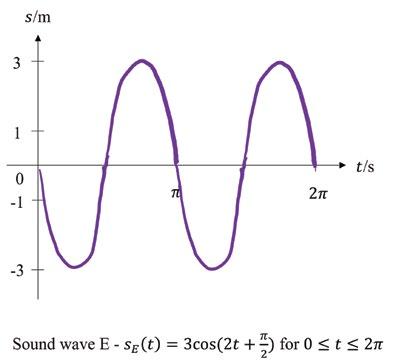
Students checked their answers using EduTech tools, including Desmos Graphing Tool and GeoGebra applet. I then instructed the students to draw another sound wave, E (Figure 3), in the third question. The sound wave is the anti-wave of sound wave D. Lastly, I prompted students on what would happen when sound waves D and E were superimposed together and where such operations can be applied in real-life scenarios.
Two sound waves, C and D, can be represented by the following equations, where s is the displacement of an air molecule (in metres) and t is the time in seconds:
Sound wave C
s� (t) = 2sin (1/2t), 0≤ t ≤2π
Sound wave D
s� (t) = 3cos (2t - π/2), 0≤ t ≤2π
Question 1: Draw the graphs of sound waves C and D.
Question 2: Can you comment on how the loudness and pitch of sound D differ from that of C?
Question 3: Go to https://www. desmos.com/calculator, enter the equations for sound waves C and D and check your answer for Question 1. Go to https://www.geogebra. org/m/Vet82Qy3 and adjust the shapes of sound waves C and D to what you have as your answer in Part 1. Note that the equations are different in GeoGebra, but make
sure the shapes are similar. Check if your answers for Question 2 are correct.
Question 4: Sketch the graph of sound wave E, sE (t) = 3cos (2t + π/2) for 0 ≤ t ≤ 2π.
Question 5: What do you think will happen to the sound if we add sound wave E and sound wave D together?
Post-class segment
I concluded the class by directing students to participate in a survey related to the learning activity. Table 3 in the ‘RESULTS AND DISCUSSIONS’ section gives the list of survey questions. I also asked students to write down their feedback on the learning activity. I allocated three tutorial questions on trigonometric functions and graphs for students to practise under the postclass segment – these questions reinforce their learning on the topic.
RESULTS AND DISCUSSIONS
Learning activity
Most groups of students were able to complete the learning activity with little guidance. The last question, on whether the superimposition of sound waves D and E will lead to sound cancellation, aims to stretch students’ thinking. Students had to come up with examples of how sound cancellation can be applied in engineering.
Some of their answers include noise cancellation headphones and signal processing. This illustrates
that students understood how trigonometric graphs are related to the quality of sound and can apply the concepts to answer questions associated with higher levels of Bloom’s taxonomy.
I carried out a survey after the class to assess the efficacy of the learning activity in benefitting students’ learning. Students answered the survey questions, based on a Likert scale of 1 to 5, illustrated in Table 2. The survey questions are shown in Table 3 and the responses are illustrated in Figure 4 and Table 4.
It is extremely encouraging to see positive feedback, as indicated by the students’ post-class survey results – a notable 82% of them expressed agreement and strong agreement to questions related to the learning activity and would like to participate in more of such learning activities. I am heartened to know that the pilot study has helped students better appreciate the application of trigonometric functions and graphs in engineering.
I examined the use of case studies in the BM module taken by first year engineering students at Singapore Polytechnic. I designed a case study that allowed students to apply concepts that they have learnt, on the topic of trigonometric functions and graphs, to audio (sound) signal processing. Students have gained a nuanced understanding of the underlying rationale behind studying trigonometric functions and graphs, emphasising their relevance to engineering.
I received positive feedback from students’ post-class survey results – 82% of them responded with “agree” and “strongly agree” that the case study has helped them better understand the topic and how it extends to applications in the real world. This pilot study exemplifies how case studies can be used as an approach to let students appreciate the relevance of mathematics in real-life applications and in their future studies or careers.
Likert scale
1 I can state some examples on how trigonometric functions and graphs are applied in engineering.
2 How useful is it to you that learning activities, like the one we did today, helps you to better understand a topic and how it is applied to a real-life application?
3 Do you have any feedback regarding the learning activity?
Table 3: Survey questions posted to students after the class.
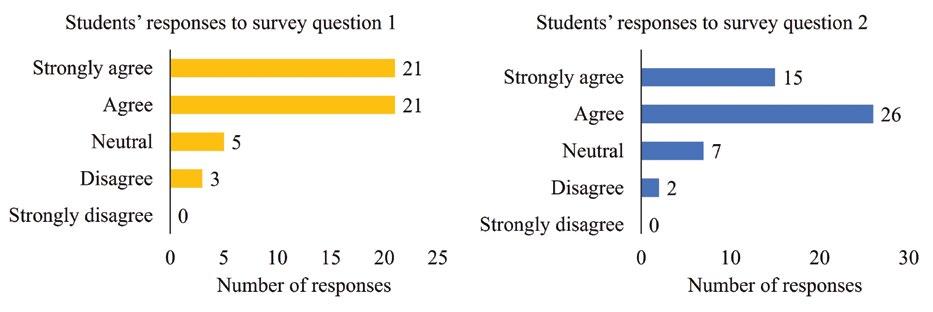
“I hope tutorials to be like this more often.”
“I now understand how trigonometric functions can be used in real-life application.”
Table 4: Students’ responses to Survey Questions 3.
REFERENCES
Davis B G (2009): ‘Tools for teaching’, John Wiley & Sons.
Harris D, Black L, Hernandez-Martinez P, Pepin B, Williams J and The Transmaths Team (2015): ‘Mathematics and its value for engineering students: what are the implications for teaching?’, International Journal of Mathematical Education in Science and Technology, 46(3), 321–336.
Bonney K M (2015): ‘Case study teaching method improves student performance and perceptions of learning gains’, Journal of Microbiology & Biology Education, 16(1), 21–28.
Ooi A (2007): ‘An analysis of the teaching of mathematics in undergraduate engineering courses’, Proceedings of the 2007 AaeE Conference, Melbourne, Australia.
Khan Academy (2014, January 2): ‘Sound Properties (Amplitude, Period, Frequency, Wavelength)’, https://Www. Youtube.Com/Watch?V=-_xZZt99MzY. Desmos (no date): ‘Graphing Calculator’, https://Www.Desmos.Com/Calculator. GeoGebra (no date): ‘Sound waves modelled as sine functions’, https:// www.geogebra.org/m/Vet82Qy3.
[This article is based on a paper presented at the World Engineers Summit (WES) 2023, held in Singapore, from 8 to 10 November 2023. WES 2023 was organised by the Institution of Engineers, Singapore (IES).]
Conditions can be created to support a smooth transition to electric construction sites and emission-free contracting.
A multi-partner study, ‘Electric Worksite’, which mapped the infrastructure needs for electric machines through testing at real-life worksites in Gothenburg, Sweden, has confirmed that electric machines equal diesel machines in performance and offer added advantages.
The added advantages include zero exhaust emissions and a better working environment.
Societies today are transforming towards more sustainable city planning. Fossil-fuel-free construction plays a major part in accelerating that shift and making progress towards national and global climate, environment, and air quality goals. The electrification of the construction sector will greatly contribute to a reduction in greenhouse gas
emissions, noise pollution and other harmful emissions, ensuring it plays a central role in sustainable community building.
In parallel with rising demand for emission-free construction contracting and a growing market for electric machines, the need for collaboration between all players across the value chain is also increasing to ensure the infrastructure is up to par for the change. This puts new demands on the energy supply and electrical system, among other areas.
The goal of the Electric Worksite project was for several players across the supply chain to come together, to gain an important understanding of the opportunities
and needs, when putting to work electric equipment in urban applications. The project, which recently presented its final results, has had a clear focus on the system perspective, testing electric machines, energy storage and charging infrastructure, in different urban sites, to clarify the varied needs across interconnected technical and organisational systems.
The tests were carried out in real-life construction sites with electric-powered wheeled and crawler excavators, wheel loaders and load carriers, weighing between 3.5 t to 30 t. Some of the machines were battery-powered and others cable-connected. The study concluded that all tests have been successful, with the following main lessons:

• Electric construction machines can perform the same work to the same standard as fossil-fuel-driven Variants, in urban construction projects.
• Workers in and around electric machines experience several positive effects in the handling of machines and the working environment.
• Like most construction projects, in general, the success of electrification is based on foresight, planning and flexibility.
• New requirements for power supply are solved, based on machine type and available electricity – such as electrical cabinets, mobile charging stations, cable-connected machines and potentially also energy storage units.
• End-customers need to be made aware of new opportunities and challenges with electric machines, as well as of existing business conditions and contracting requirements for contractors and subcontractors.
Volvo CE is one of the collaborators, that has played a key role in the research project, by project-managing the tests and providing electric machines in various sizes and models, as well as technical solutions for charging, mobile energy storage and cable management.
“Electric machines are already available on the market and performing well, but the challenge can often be how to establish a reliable supporting infrastructure. This project confirmed that when all actors in the value chain around a construction site collaborate, both from the public and the private sector, we solve the infrastructure around it. In all tests, regardless of application and location, the electric machines performed as well as, if not better than, equivalent models with combustion engines, but without harmful emissions and disturbing noise”, said Bobbie Frank, Research Leader at Volvo CE.
Municipalities and government bodies play an important role in enabling and driving the transition, for example, by setting requirements for emission-free vehicles and ma-
chinery in the procurement of construction work, and by establishing clear city development goals for all societal players to work towards.
The City of Gothenburg was keen to be involved in this project, seeing that there are many benefits in accelerating electrification within construction.
“As the City of Gothenburg is a major procurer of construction and civil engineering contracts, we want to be involved in leading the transition towards an emission-free industry. We also see many other benefits for both the surrounding environment and the working environment, such as reduced noise and improved air quality”, said Peter Lindgren, Business Developer for Electrified Transports at the Environmental Management Department, City of Gothenburg.
For the construction contractor NCC, the Electric Worksite has meant evaluating opportunities and challenges with electrification, together with other actors in the value chain.
“Once again, we can conclude that the most important take-away is that we need to get involved early in the project to plan for electrification – because the opportunities to influence emissions are greatest in the planning stage. To scale up the use of electric construction ma-
chines and vehicles, increased competence is also needed throughout the value chain. We also need electric machines to be demanded in the contracting, by customers, and that they set requirements that drive the development forward,” says Pernilla Löfås, Sustainability Manager, NCC Infrastructure.
Partners
Volvo Construction Equipment
NCC Sweden
Gothenburg City
Chalmers University of Technology
Lindholmen Science Park
Gothenburg Energy
Johanneberg Science Park
Gothenburg City Leasing
RISE Research Institutes of Sweden
ABB Electrification Sweden
Riksbyggen
HSB Gothenburg
Halmstad University
Period 2021-2023
Funding
FFI, Strategic Vehicle Research and Innovation
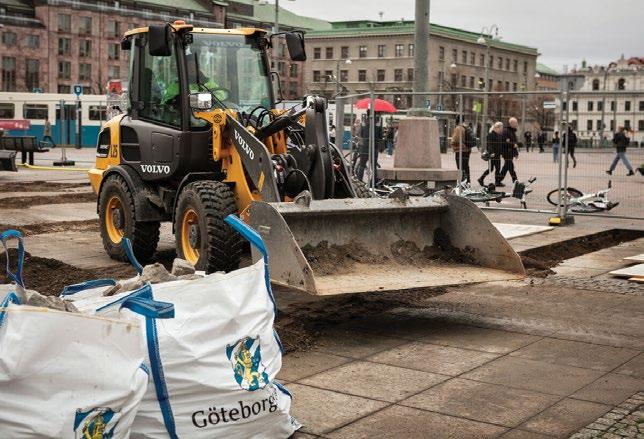
The latest generation of waterproofing membranes was used in the redevelopment of the historic Castel Nuovo in Naples, Italy.
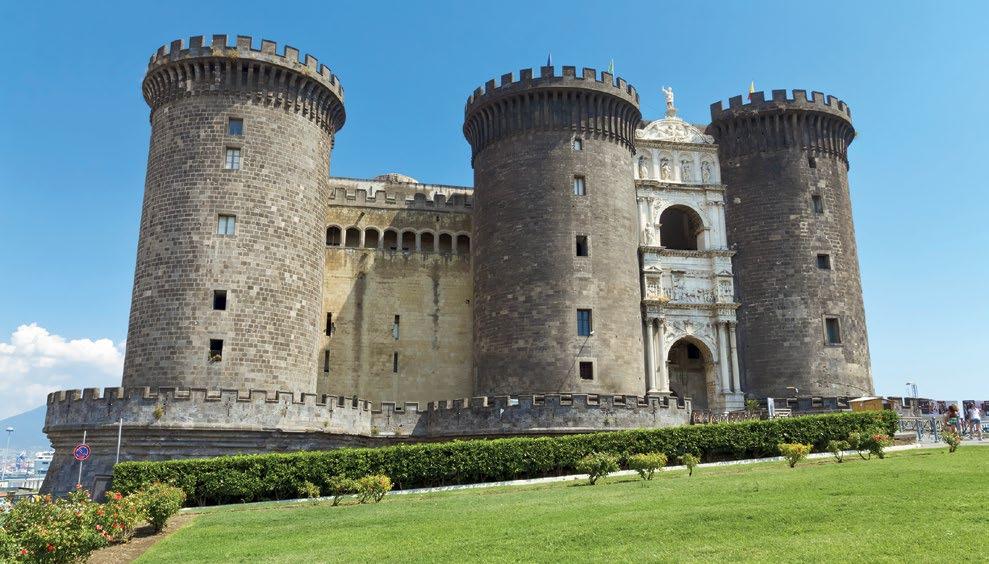
Castel Nuovo is one of the symbols of Naples and, for almost a thousand years, the theatre and a spectator of the history of the city.
Its construction started in 1279, under the reign of Charles I of Anjou (from whom it takes its commonly used name of Maschio Angioino), following which, over the centuries, it underwent various extension and renovation works.
Today it maintains the same look it was given, midway through the 15th century, by Alfonso I of Aragon – as an imposing building with a trapezoidal footprint, encircled by five mighty, round towers.
During the Middle Ages and the Renaissance era, it was the home of several monarchs, from the Angioine and Aragonese dynasties to the Bourbon dynasty in the 17th century, when court life transferred to the new Royal

Work was carried out to waterproof the roofs of the building, over a total surface area of around 2,500 m2
Palace. A centre of culture in the 14th century – with the presence of talented authors and painters like Francesco Petrarca, Giovanni
Boccaccio and Giotto – it is now the home of various historical and cultural associations and the City Museum.
Visitors are able to admire the Palatina Chapel, the only part that remains of the 14th century Angioine castle; the Baroni Hall where, until 2006, Naples City Council held meetings; the Armoury Room; along with numerous frescoes and paintings.
Redevelopment work
Mapei took part in the redevelopment work on Castel Nuovo as Official Sponsor. After replying to a request for tender issued by the City Council, a joint team was set up between Mapei and the companies, Saces, Studio Discetti, Consorzio Campale Stabile and BTA, to carry out the entire operation free-ofcharge – from design work to works management, right up to the supply of materials and execution of the work.
Work was carried out on the roofs of the building to counteract the serious infiltrations of water into the Baroni Hall and the San Giorgio Tower, along with the adjacent areas, over a total surface area of around 2,500 m2
Substrate preparation
The first step was to prepare the substrates, each of which was approached differently, according to the extent of the damage and the type of surface. Three quarters of the substrates was made up of badly deteriorated bituminous membranes, while the remaining portions were protected with a liquid-applied membrane.
In the areas with the bituminous membrane, which was suffering from localised damage, the membrane was cut and lifted, the water that had accumulated underneath was removed and then the membrane was fixed back in place.
The next step was to apply PRIMER PU 60 one-component, moisture curing polyurethane primer, to prepare the substrate for the waterproofing treatment applied thereafter.
In the areas with the liquid-applied membrane, on the other hand, the membrane was removed with a grinding machine, to get rid of all traces of products and any loose material, and the substrate was re-
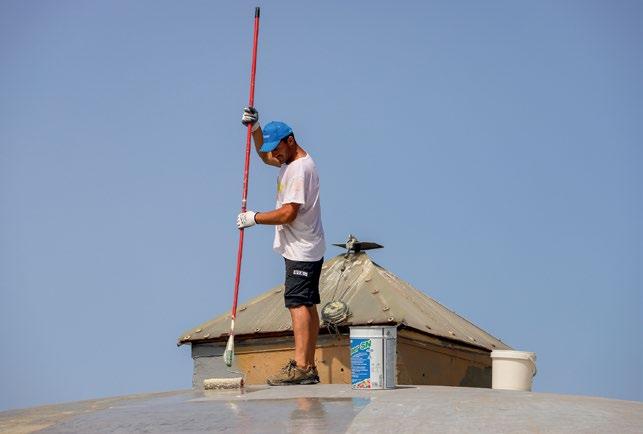
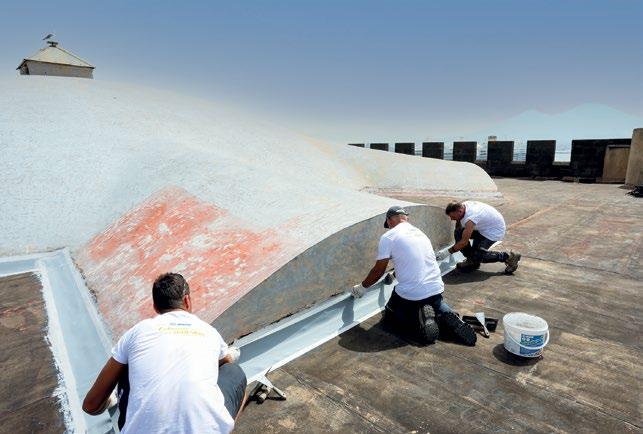
paired by applying MAPEGROUT 430 fibre-reinforced thixotropic mortar (which is now available as MAPEGROUT 430 ZERO).
Once the membrane had been removed and the cementitious substrates had been levelled off, a coat of PRIMER SN, a two-component, fillerised epoxy primer, was applied and then broadcast with QUARTZ 0.5 sand.
After cleaning the metal work with grinders and pneumatic drills, it was sanded down and a coat of MAPEDECK PRIMER 200 adhesion
promoter for polyurethane systems was applied.
MAPEBAND TPE, a TPE tape designed for elastic waterproofing and sealing expansion joints and cracks subject to movement, was placed in the slope changes and joints to give continuity when applying the polyurea membrane. The tape was bonded with ADESILEX PG1 adhesive.
Waterproofing the surfaces
Once the substrates had been prepared, it was time for the actual waterproofing of the surfaces, which


was achieved by spray-applying PURTOP 500 N two-component, solvent-free, rapid-reticulation, hybrid polyurea membrane, with a bi-mixer pump, at a rate of 2.2 kg/m2 and with a thickness of around 2 mm. This system adheres firmly to substrates and, after reticulation, forms a strong, continuous, and flexible membrane, ready for foot traffic, very soon after application. Thanks to its high tensile strength and crack-bridging capacity (including at low temperatures), this product is able to adapt to substrates of any
shape or form, without cracking. The final stage was to apply two coats of coloured MAPECOAT PU 20 N two-component, aliphatic polyurethane topcoat for membranes from the PURTOP range. Where required, QUARTZ 0.5 sand was applied, between the first and second coats, to create a non-slip, matt finish.
PROJECT DATA
Project
Castel Nuovo, Naples, Italy
Original design
Pierre de Chaule
Period of original construction 1279-1384
Current owner Naples City Council
INTERVENTION BY MAPEI
Year of the renovation intervention 2023
Contribution by Mapei
Supply of products for waterproofing roofs
Designer and works direction Paolo Discetti
Contractors
BTA Srl
Consorzio Campale Stabile
Application of Mapei products
Preparing substrates –PRIMER PU 60, MAPEGROUT 430, MAPECOAT I 600 W, QUARTZ 0.5, PRIMER SN, TRIBLOCK P, MAPEDECK PRIMER 200
Waterproofing – PURTOP 500 N, MAPEBAND TPE, ADESILEX PG1
Finishing the surfaces –MAPECOAT PU 20 N
Website for further information www.mapei.com/sg utt.mapei.com
(Some products are available in Singapore. Please contact customer service at Mapei Far East for the available products.)
The digitalisation of construction can significantly enhance connectivity across various project facets – at every stage of the building lifecycle.
Digitalisation is the process of converting all of a team’s construction processes into a digital format. This transformation helps to reduce costs, improve productivity, decrease errors, streamline processes, and minimise waste, ensuring projects are executed correctly every time.
Eunoia Junior College, in Singapore, exemplifies architectural integration and intensification, by utilising a 4-hectare site that is approximately a third smaller than typical junior college sites. Despite this constraint, the 51,000 m2 campus serves as a vital educational institution embedded within the Singaporean community.
Commissioned in 2020, Eunoia Junior College stands out as Singapore’s first high-rise junior college. It features an elevated running track and field, and an integrated development that includes a community centre. Additionally, the teaching block incorporates Mass Engineered Timber (MET) solutions, utilising Glued Laminated Timber (Glulam) and Cross Laminated Timber (CLT), and deploying cutting-edge construction techniques and sustainable building practices.
The Eunoia Junior College project presented several unique challenges due to its complex architectural and technical features. The scope of the project was extensive, encompassing a turnkey approach that included structural, interior and fitout works.
Notably, this was the first project
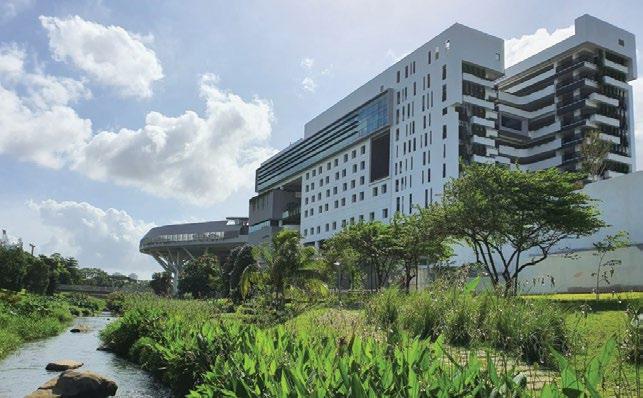
in Singapore to feature a full-scale, 400 m elevated stadium, a remarkable architectural achievement. The use of MET and a timber-hybrid slab system in the building project represented a significant advancement in construction techniques.
Kimly Construction, the main contractor, engaged PlanRadar to digitise site management, scheduling and reporting, for the project.
After implementing PlanRadar’s solutions, Kimly Construction reported positive outcomes. The PlanRadar platform’s easy customisation allowed it to be tailored to specific project needs, while its user-friendly interface ensured accessibility for all team members. PlanRadar proved effective in managing tasks across the site, on a single platform, leading to more streamlined operations. This efficiency translated into shortened build timeframes and improved scheduling accuracy.
Throughout the project, Kimly Construction benefitted from robust customer and technical support,
which facilitated smooth implementation and ongoing use for managers and contractors alike. Additionally, the features of the PlanRadar platform supported the achievement of sustainability certifications, aligning with Kimly Construction’s commitment to environmentally responsible construction practices.
The result was a complex construction project successfully completed on time, within budget and according to specification.
“Just one week preparation and training, and we went live with the system,” said J Chew, Senior Manager, Business and Quality Excellence, Kimly Construction.
PlanRadar is an award-winning digital B2B platform that creates timeand cost-savings in construction and real estate projects, by digitising task management, documentation and communication, for over 150,000+ users in 75+ countries worldwide.
More information can be obtained from www.planradar.com.
Upon completion in 2025, the structure, designed by Zaha Hadid, and located on the outskirts of Taipei, Taiwan, is expected to be the world’s longest asymmetric cable-stayed bridge, at an impressive 920 m.
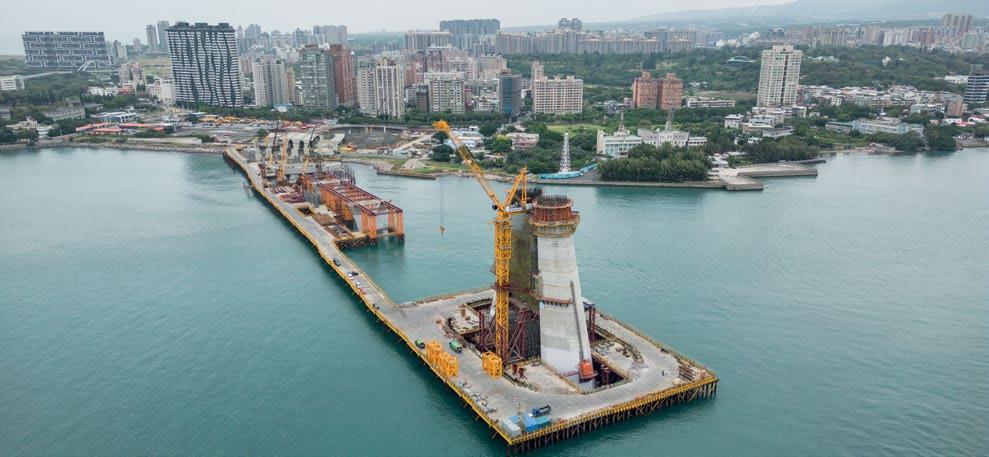
The pier of the bridge rises 200 m above the water surface of the river and required detailed planning, in compliance with strict safety guidelines. PERI is assisting with the project by providing individually planned and coordinated formwork and engineering solutions to ensure that the unusual pier design can be constructed on schedule.
An architectural artwork
Zaha Hadid won the Danjiang Bridge International Competition back in 2015 for her design of the asymmetrical bridge.
Once completed, the bridge will connect Tamsui District in New Taipei City with the Bali District across the Tamsui River – thus relieving the pressure on other transport routes. In addition, the Danjiang Bridge will become a new, unmistakable landmark of the city.
The pylon in the centre of the
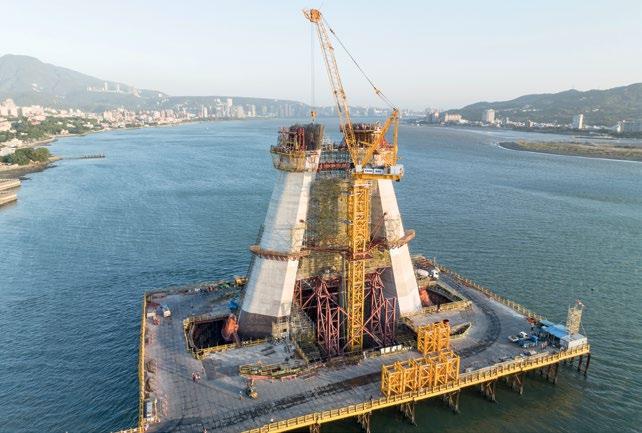
bridge is the real eye-catcher. It towers into the air in the shape of an upturned ‘Y’ and stands, figuratively speaking, with its two legs in the river. The stay cables, which run
in parallel to the top of the pylon from both sides, give the structure a futuristic appearance.
PERI was involved in the construction of the pylon, by providing,
among other things, a custom-designed formwork solution for concreting a total area of 18,000 m². To create this futuristic look, PERI developed a freeform formwork system, specifically for the project, to construct 3,000 m² of the entire surface. The complex, ever-changing shape of the pylon, which stretches upwards over 53 sections, posed the biggest challenge. PERI provided versatile VARIO, SCS and ACS, which could be individually adapted to the varying geometry.
Everything from a single source PERI Systems are characterised, in particular, by their adaptability to unusual project requirements as well as their compatibility with other PERI products. Using PERI’s standard portfolio as a basis, the engineers from PERI came up with a coordinated, customised solution, from a single source, for each section of the unique pylon shape. As such, the VARIO GT 24 Girder Wall Formwork provided the ideal foundation for each section of the 200 m high pylon. This dimensionally stable formwork makes it possible to pour up to 18 m of concrete at a time.
Hitting the heights safely and quickly
To realise the various shapes and radii of the pylon, PERI Climbing Systems were used alongside formwork solutions. A combination of ACS and SCS was chosen to ensure that processes were quick and efficient. The SCS Climbing System made it possible to construct the inclined design at the upper and lower ends. To help construct the central, straight section, the ACS Self-Climbing System was used, which climbs up the emerging building on rails.
Project support during construction PERI engineers are on hand to advise the construction site team throughout the project. From start to finish, the experts provide support with planning and preparation, on-site construction and final completion. The intensive, detailed planning process and on-site
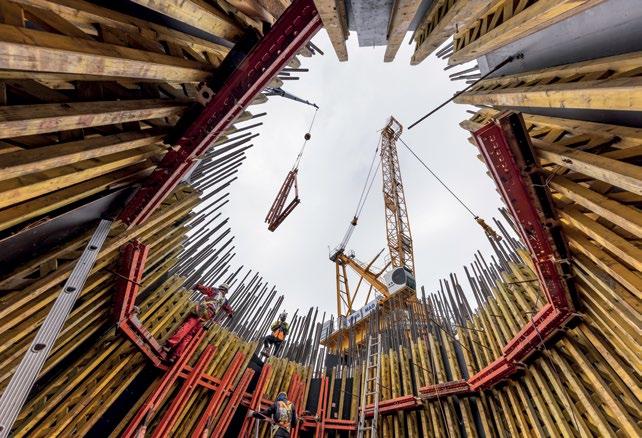
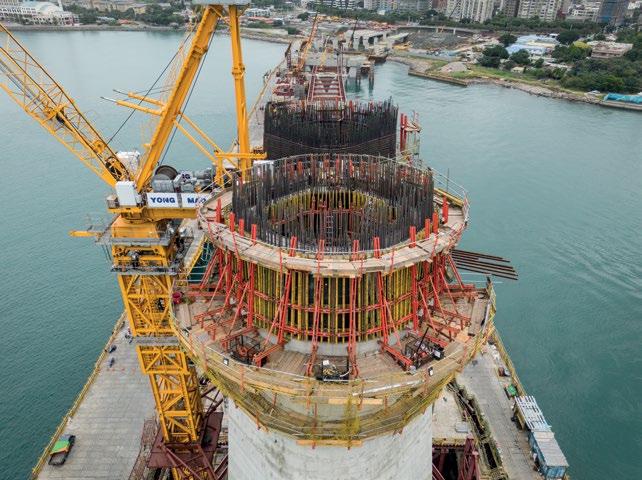
support have ensured rapid construction progress. This enables the project requirements to be met and the tight construction schedule to be adhered to. In this way, the project requirements can be met in order to get closer to the planned completion date of 2025.
PERI is one of the leading manufacturers and suppliers of formwork and scaffolding systems. With a
workforce of around 9,100 employees and well over 160 warehouse locations in more than 70 countries, the family-owned company with its headquarters in Weissenhorn, Germany, provides its customers with innovative system equipment and comprehensive services relating to all aspects of formwork and scaffolding technology.
All images by PERI SE
The new Cat 973 Track Loader can clear, load, dig, carry, fill and undertake other activities, even under tough ground conditions. The new Cat 973 Track Loader combines versatility with up to 10% better fuel efficiency, more productivity, cab improvements and the optional Cat Payload technology.
The 275 hp (205 kW) crawler loader has an operating weight of 65,901 lb (29 892 kg) and replaces the 973K, worldwide. It joins the 953 (160 hp/119 kW) and 963 (202 hp/151 kW) in the Cat track loader line.
Operation made easy
The 973 is a large track loader in the industry, yet it offers agility and ease of operation. The updated cab features a suspension seat and adjustable armrests / controls. An intuitive, 10-inch (254 mm) touchscreen dash display is easy to use and features a standard high definition rearview camera. ‘Slope Indicate’ helps make operation easier, by showing machine mainfall and cross slope right on the display.
The operator can select joystick or V-lever and pedal steering for transmission controls, and either joystick or 2-lever implement controls. The joystick option provides familiar controls for operators experienced with skid steers/compact track loaders. With either control scheme, operators can set implement response – fine, normal, coarse – to match operator preference or application. Repetitive lift, lower, rack, dump and float functions can be preset to make jobs like truck loading easier. Smoother implement and steering response, and improved steering performance provide more controllability.
More productivity and lower fuel consumption
The 973 is powered by a Cat C9.3B engine. Fuel consumption is reduced up to 10% with the Auto Mode that will adapt the engine speed to the load. Eco Mode will use even lower
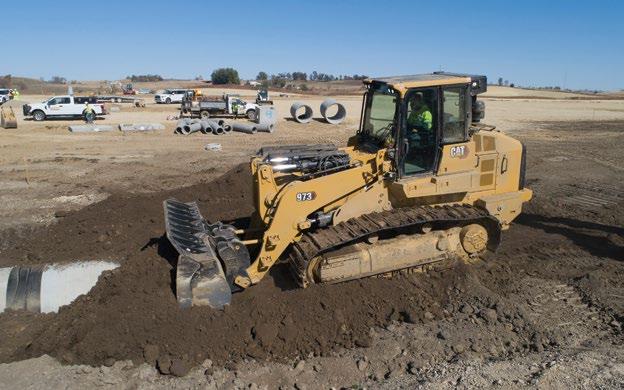
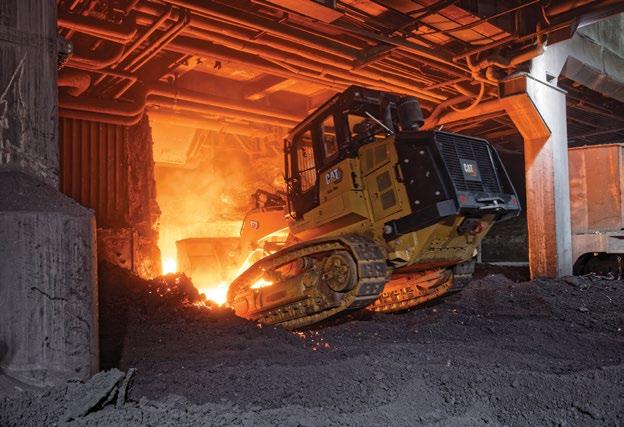
speed for further reduction in fuel consumption in lighter duty applications. Power Mode will keep engine speed high at all times.
An optional Performance Series bucket boosts productivity up to 20%. An optional Fusion Quick Coupler enables fast attachment changes. A variety of buckets, forks and other tools can be shared among track loaders, wheel loaders and other Fusion-compatible machines.
Buckets come from the factory with Advansys bucket tips / adapter / locking system. Advansys tips are built for maximum productivity and
the lowest bucket lifecycle cost. The hammerless retention system ensures safe, fast removal and installation without special tools.
Purpose-built Low Ground Pressure (LGP), Waste Handling / Demolition and Ship Hold arrangements are factory-equipped with specialised undercarriage, guarding and other features designed to take on tough tasks. The 973 Steel Mill package includes a specialised cab, insulated steel fuel tank, high temperature undercarriage and insulation throughout the machine, making it suitable for handling slag.
With the 20 t and 25 t HC 200i C VA and HC 250i C VA models, Hamm is now offering a range of compactors that enable automatic compaction to a specified target value in earthworks. The models are initially available in markets with EU Stage V / EPA Tier 4f exhaust emission standards and, in due course, in other markets.
The abbreviation ‘VA’ stands for Variable Amplitude. An essential element of this technology from Hamm is the equally new, parameter-independent Smart Compaction Value (SCV).
With the Smart Compaction product family, Hamm has developed a range of solutions for smart and simple compaction. A further development that automates and simplifies compaction in earthworks and simultaneously improves quality and cost-efficiency has now been implemented in the new HC series models with VA drums.
Operators can quickly and easily learn how automatic compaction works, as all that the compactor driver has to do, in daily operations on the construction site, is choose between an automatic mode and a manual mode. While the amplitude is automatically regulated by the machine control system in automatic mode, the manual mode allows the compactor driver to choose any one of five preset amplitudes.
The function is operated via the already familiar Easy Drive display. In addition, a compaction target value in MN/m2, based on typical load bearing capacity values, can be specified before the start of compaction. In automatic mode, the compaction process is then controlled by Smart Compact until the specified target value has been achieved.
The decisive factor here is the also newly developed Smart Compaction Value (SCV). The measurement is carried out by the Smart Compac-
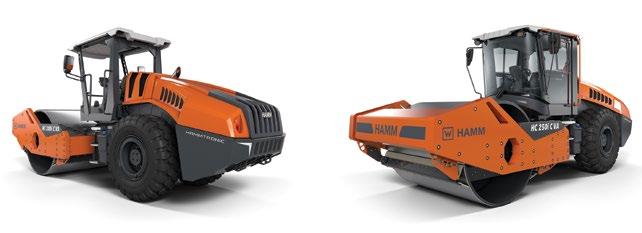

tion Meter (SCM). The compaction value is also independent of key influencing factors, for example the travel speed, the direction of travel or the frequency, which leads to high comparability of the measured values, even when using compactors of different weight classes.
advantages
The use of the new VA compactors brings various advantages for operators and construction contractors. For instance, the automatic compaction control not only ensures homogeneous compaction results, but also effectively prevents over-compaction or particle crushing at the same time. The VA compactors are therefore an attractive solution, as they make it easy for even inexperienced operators to achieve consistently high process reliability and quality.
The cost-efficiency of construction projects is also improved through the fewer compaction passes re-
quired, the correspondingly lower diesel fuel consumption and the reduction of mechanical loads on the machine. The smaller number of passes required is naturally also accompanied by a corresponding reduction in CO2 emissions.
Furthermore, the avoidance of jump operations caused by the machine control system leads to longer machine life. In view of the direct adjustment of the amplitude, the new technology can be considered to be an energy-efficient system.
Broad spectrum of applications
With regard to potential applications, the new compactors are ideal for the compaction of cohesive, sandy and coarse-grained soils. Thanks to the high compaction forces that reduce the number of passes required, VA compactors are also an effective solution for the compaction of thicker layers of rubble. This makes the machines a particularly versatile option for a variety of applications.
With the LBX 600, a new carrier machine for slurry wall construction, Austrian company, Liebherr-Werk Nenzing GmbH, is responding to the special challenges faced on urban jobsites. The compact size combined with the unplugged version enables work in even the most confined spaces and noise-sensitive areas. The LBX 600 can be flexibly equipped and customised to meet site requirements, thanks to a modular system with three different booms.
The standard version of the machine has a total height of 17.8 m. For applications with restricted height, e.g. working under bridges, the Low Head with 11 m or Ultra Low Head with 5.8 m can be used. The LBX 600 has a slim design. The compact basic machine can be transported in one piece, as the track width can be reduced to 3 m, thanks to the telescopic undercarriage.
The carrier machine is not only designed for work, using a hydraulic grab, but also with a mechanical grab or chisel, thanks to the two free-fall winches with a line pull of 300 kN each. In combination with the HSG 5-18 hydraulic slurry wall grab, the LBX 600 offers intuitive operation which also enables hydraulic corrections to the grab alignment and thus a higher verticality of the trench.
The hydraulic slurry wall grab is modularly designed and has a robust base body. With the HSG 5-18 C and HSG 5-18 L grabs, as their names imply, slurry walls with thicknesses between 500 mm and 1800 mm can be installed, depending on the composition.
The compact (C) version or the low head version is the standard design for the LBX 600, while the base body of the large (L) (large) version is 2.5 m longer. The resulting to-
tal height of the grab at 9.5 m and the high weight with low centre of gravity provide for even better vertical positioning and is especially advantageous when installing larger dimensioned slurry walls. When working in difficult ground conditions, the execution of the work can be improved through increasing the dead weight of the grab with an additional weight of 4.4 t or 6.5 t. Bites with lengths of 2500 mm to 3400 mm and maximum depths of 80 m can be excavated with the grab.
The slurry wall grab is fitted with a hydraulic rotating device which allows the grab to be aligned in all directions and provides for quick and operator-friendly 180° rotation after each grab cycle. The high cylinder force of 1527 kN ensures high performance, even under extreme conditions. The fill level indicator on the grab ensures high productivity throughout the entire application. The maximum permissible grab weight, i.e. grab including filling capacity, is 30 tonnes.
Conventional and battery-powered versions
The LBX 600 is available in both conventional and battery-powered versions (LBX 600 unplugged). Both versions have identical performance data. One feature of the unplugged version is zero emission. It does not produce any exhaust fumes and is quiet. This makes it suitable for use in noise-sensitive regions.
The battery is charged using conventional jobsite electric supply. Operation can continue, as normal, while charging.
Liebherr offers the LBX 600 and the LBX 600 unplugged as a complete package with the hydraulic slurry wall grab, HSG 5-18.
All working processes for slurry wall construction can be electronically recorded and visualised, using
the process data recording system, PDE. The system is operated and displayed on the PDE touchscreen in the cabin. PDE records operating data from the Litronic control system, as well as data from external sensors.
Using the MyJobsite software solution, all relevant process, machine and jobsite data can be recorded, displayed, analysed, managed, and evaluated in one central location. The collected data can be accessed via a web browser, when an internet connection is active. With the recorded PDE data, a working protocol is automatically generated as proof of quality, directly after completion of a work process. The parameters of the driving protocol can be defined and assigned in advance, which saves time.
The LiDAT data transmission and positioning system enables the fleet management of Liebherr machines. The system supplies information about localisation as well as about the operation of the machines. This includes the machine position, operating and utilisation times, fuel consumption and service interval information.

SENNEBOGEN demolition excavators have been offering solutions for efficient and precise work on tight construction sites and at great heights. Now the 825 E Demolition has expanded the existing demolition range downwards and celebrated its trade fair premiere at IFAT 2024.
Flexible and fast in use
With an impressive reach of 14 m and good manoeuvrability, the new excavator has mastered the common challenges of selective demolition. The flexible demolition excavator, which has good stability thanks to the telescopic wide-track undercarriage, can perform selective demolition of buildings using demolition grabs, demolition hammers or pulverisers. It is also ideally suited for sorting tasks.
Thanks to its compact dimensions, the powerful new model, with an operating weight of 38 t, is ideal for use on urban construction sites and in confined spaces. The 825 E Demolition also impresses with its innovative quick-change system. A wide range of attachments, including the demolition hammer, can be used flexibly and easily changed by the driver from the cab, within a short time.
Stable and robust
Safety is ensured not only by the stable undercarriage, with an overall width of 4.2 m, but also by the cab which can be raised by 2.7 m and tilted by 30°. This allows the driver to work ergonomically, leaning back in the seat and yet having a clear view of the attachment. In addition, the robust construction of the machine and safety features ensure safe working in the demolition area.
transportation
Thanks to the hydraulically lowerable counterweight, the transport weight of the 825 E Demolition can be reduced by 10 tons so that the
machine can be easily transported without a special permit.
There is no need to dismantle the equipment – it can be transported
in one piece on a low-loader. In addition, the 825 E Demolition is immediately ready for use without any set-up work.

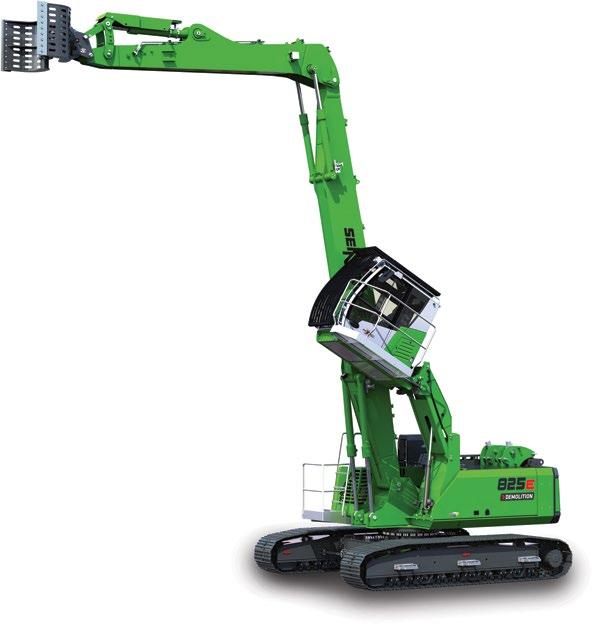
In collaboration with engineering firm AMOG Consulting, remote monitoring specialist Omniflex has developed WharfWise, a holistic structural monitoring system that provides wharf operators and asset managers with real-time oversight of mooring operations and structural integrity.
WharfWise can be used to monitor everything from movement of wharves’ dolphins to impacts on the fenders and tension in the mooring lines.
Driven by industry-wide carbon reduction strategies, cargo ships are becoming larger year-on-year, as a single ship carrying much more cargo than multiple smaller ones lowers carbon emissions per tonne as well as shipping costs per tonne. However, port infrastructure designed decades ago was not built with these larger ships in mind, meaning stresses and strains on the infrastructure are much greater than anticipated.
Furthermore, as there is increasing pressure on port operations to maximise existing assets, port infrastructure is occasionally operated beyond its capacity or asset life. This can impact the performance, as errors in operation or adverse weather conditions can cause additional and unexpected movement in berthed ships, which can then excessively load mooring lines and cause impacts on berth infrastructure.
According to AMOG, there is almost no existing real-time feedback loop about whether operating with larger ships, often in adverse weather windows, fits the wider asset management strategy.

With the introduction of larger ships, port infrastructure is subjected to greater stresses and strains.
On the other hand, WharfWise can correlate a wide range of data to within a millisecond, so cause and effect can be determined. For example, if a ship collides with a fender and causes a wharf pile to move excessively as a result, WharfWise can easily map the chain of events to provide immediate insights to operational and engineering personnel.
The traditional approach to port asset management has seen operators rely on visual inspections, often on an annual basis, to identify damage and conduct patch repairs. However, in the case of concrete structures, by the time the damage is visually identifiable with cracks in the structure, it is likely approaching the end of its service life and the maintenance cost drastically increases.
According to Omniflex, WharfWise helps detect stress that could lead to damage, and proactively maintain the asset by managing the main
loads into the berth and the berth’s response. For example, too much movement is indicative of deeper structural issues.
WharfWise also allows real-time adjustments of mooring lines, to respond to unexpected ship movement, caused by weather conditions or changing tides. This helps maintain an even load distribution across all lines, at all times, and minimise damage. In turn, safety is enhanced, as a snapped mooring line can result in a serious incident that endangers port personnel.
As WharfWise provides port asset managers with detailed, timestamped data on port infrastructure performance, it can also help them recoup capital costs for damage from ship operators. This was previously much harder to do as it was difficult to accurately identify the exact events responsible for any damages.

